ATHLETICS & WELLNESS
What is SOCIAL-EMOTIONAL LEARNING?


ATHLETICS & WELLNESS
What is SOCIAL-EMOTIONAL LEARNING?

Head of School:
Aaron Cooper
Editors:
Brooke Arthur
Kent Findlay ’80
Contributors:
Brooke Arthur
Ellen Baer
Susan Barr
Diane Briggs
Ryan Buckley
Holly Donaldson Casella ’04
Susan Chiavaroli
Rebecca Comizio
Tara Coniglio
Aaron Cooper
Kent Findlay ’80
Jen Gifford
Nora Goddard
Brayden Henry
Scott Lilley
Mark Macrides
Will McDonough
Moina Noor
Jody Sheldon
Carin Walden
Design:
Good Design, LLC
Printer:
J.S. McCarthy Printers jsmaccarthy.com
Photography:
Brooke Arthur
Aron Back
Rich Barnes
Bob Cornell
Kent Findlay ’80
Meaghan Mallin
Moina Noor
Wade Sunko
Chi Chi Ubiña
Elaine Ubiña
Torrance York
Address changes: communications@countryschool.net
On the cover: Thomas Godina explores the woods
Photo credit:
Chi Chi Ubiña
2018–2019
President:
Randall M. Salvatore
Vice President:
Stephanie Bowling
Zeigler ’81
Treasurer:
Christopher T. Baker
Secretary:
Sarah M. Irwin
Members-at-Large:
Yolanda Seals-Coffield
Smita Singh
Aaron C. Cooper, Head of School
Dr. Christopher M. Bogart
Lynne F. Byrne
Drew Casertano
The mission of New Canaan Country School is to guide students to reach their intellectual, creative, moral, and physical potential. We value the imagination and curiosity of children and respect childhood as an integral part of life. Our teachers set high academic standards and challenge students to question, to think, to collaborate and to act with integrity. The school works in partnership with families to teach personal, social, and environmental responsibility, and to create a community that honors diversity and our common humanity. New Canaan Country School inspires students to be lifelong learners with the courage and confidence to make a positive contribution to the world.

Tara J. Coniglio
Michael J. DiBiasio ’90
Gary D. Engle
F. Tucker Golden ’90
Mariko G. LeBaron
Monique S. Mims
Michael Riccardi
John M. Ryan
Michael S. Sotirhos
Brennen Strine
Sharon Gibbons Teles ’88
Caitlin A. Walsh
Wilson S. Warren
Megin E. Wolfman
Faculty Representatives:
Elizabeth M. Carroll
Hannah M. Liu
PARENTS’ ASSOCIATION
EXECUTIVE COUNCIL
2018–2019
President:
Tara Coniglio
President-Elect:
Susan Barr
Treasurer:
Marcy Smith
Secretary:
Liz Keogh
VP Community, Diversity & Inclusion:

Michelle Saldivar
VP Community Service:
Leigh Kennedy
VP Volunteers:
Marnie Gizzie
ALUMNI COUNCIL
2018–2019 President:
Tucker Golden ’90
Vice President: Sanny
Burnham Warner ’88
Emily Coughlin Basaran ’98
Dan Bergfeld ’58
Matt Bloom ’98
Dick Colligan ’01
Michael DiBiasio ’90
Taylor Gould ’06
Marshall Johnson ’04
Caitlin Maguire ’04
Suzy Gibbons Owen ’94
Elena Kavanagh Phillips ’91
Kelsey Hubbard
Rollinson ’86
Richard See ’75
10
Emeritus:
Carl Brodnax ’76
Hugh Halsell ’59
Paula Kennedy Harrigan ’81
Carl Rohde ’66
Kit O’Brien Rohn ’78
Stephanie Bowling Zeigler ’81
Ex Officio:
Aaron Cooper, Head of School
Terry Gumz, Director of Advancement
Holly Donaldson Casella ’04, Director of Alumni Affairs
Steve Bloom ’03, Former Alumni Council President

Over spring break, my family and I had the great fortune of traveling to Rome together for a week of sightseeing — soaking in the history and, of course, eating! Both of our daughters (in fifth and seventh grade) have been studying Rome this year through different lenses here at Country School, and it seemed the perfect place to spend some time. The city’s tourist attractions center around two historical periods: antiquity and the Renaissance. Both of these periods highlight eras when the ideals of the ancient Greeks were particularly revered and elevated. As someone who spent significant time in college studying these ideals of mind, body and spirit through art, politics, philosophies, scientific work and mythology, I was enthralled.
Throughout the week, as we toured the museums and landmarks, taking an accidental turn here and there past ruins and public statuary, and as I went on long runs along the ancient Appian Way, I reflected on the parallels between Renaissance and ancient Roman philosophy and our philosophy of education at Country School. The first line in Country School’s mission represents a calling to these ideals: We “guide students to reach their intellectual, creative, moral, and physical potential.” Indeed, such a holistic belief in the purpose of education of children has been at the core of Country School’s purpose since its founding. Education of children is education of the future, and what better way to consider the future than to think of it in terms of intellect, creativity, morality and physical impact. The influence of the past is evident even in the Ionic columns on the facade of Grace House (Main Building).
One of our favorite off-the-beaten-path stops during our trip was to the National Roman Museum’s coin exhibit, tracing the history of Rome from the earliest coins through the euro of today. I loved experiencing it through the eyes of my daughter, Charlotte, our fifth grader. She reveled in pointing out the various coins, having learned exactly how much an ancient bath cost during her studies at Country School. It is these moments of connection that are at the root of Country School’s curriculum. As you flip through these pages and read about Country School’s mission in action, I am certain that you will feel our dedication to the mind, body and spirit of our students.
Enjoy,
Aaron Cooper, Head of SchoolIndeed, such a holistic belief in the purpose of education of children has been at the core of Country School’s purpose since its founding. Education of children is education of the future. ”
This story has to do with distance running, because the training of a distance runner relates to the journey that takes our students from Beginners through ninth grade. Last December, just as I was coming off an injury and training regularly again, I got a call from the captain of the club I ran for, the Garden State Track Club, asking If I would join the team for the United States Track & Field Association’s Masters’ Cross-Country National Championships in Tallahassee, Florida. You see, a cross-country team needs five runners, and we had four committed. So, he asked me to be the fifth man even though I was only just starting to train again. I had four weeks, and
I trained intensively those weeks, deviating from my original training plan to prepare to run as fast as possible in that one race. At this stage, I need to speak about training for distance running in general. First off, distance runners peak in their late 20s and early 30s, later than many other athletes and after things like metabolism has slowed down and overall muscle mass has begun to decline. And that is due to the cumulative effect of smart training. Every training run points towards peaking at the right time. Interval workouts build pulmonary capacity and muscle fitness; recovery efforts — easier, medium distance runs — clear out lactic acid, helping to

Learning to skate is a rite of passage for Country School students dating back to the school’s inception over 100 years ago. Students skated on Hardon Pond from 1916 until the rink was built in 1957.
Guided by professional instructors, students in the school’s lower grades learn how to glide, stop and skate backward.
“We are so fortunate to have this lovely resource. In addition to being a great way to develop gross motor skills, skating gives us yet another way to help the children practice and ultimately master the art of resilience,” says Head of Early Childhood Beth O’Brien.
prepare the body for its next workouts without sacrificing any of the capacity the previous workout built; and long, slow distance runs build the aerobic capacity needed to make the interval workouts most effective. In the right balance, these result in the body getting progressively stronger and faster.
But that takes years, and I only had four weeks. So, I cut corners. I did far more interval work, made my long, slow runs into long, fast runs, and took fewer recovery days. I did it specifically to run as fast as possible in that championship race. So, what happened in the race, you ask? Well, I flew from Newark to Charlotte Friday evening for a Saturday morning race — I would not miss a minute of school, mind you — and promptly missed my connection to Tallahassee due to a delay. So, and this is true, I rented a car at 10:45 p.m. and started driving south. It was almost an eighthour drive, and I had 11 until the race started. I napped for two hours from 3:20–5:20 in a rest

Inspired by their reading of Roxaboxen, an award-winning children’s book written by Alice McLerran and illustrated by Barbara Cooney, second graders headed to the woods to build their own imaginary town.
Working in small groups, children whisked around the 35-acre outdoor classroom space stacking logs, piling stones, exchanging acorns and leaves as imaginary money, and created bakeries, pet shops, jail cells and more. One group shrieked with delight when they caught a frog and quickly sold it to another group in exchange for imaginary groceries.
Back in the classrooms later that September afternoon, students reflected on their experiences, connecting what they had seen and done to the school’s mission skills: teamwork, ethics, resilience, curiosity, time management and creativity.
“People were being so kind and including each other,” said Charlotte Tocks.
The second grade Roxaboxen tradition is just one of many Country School teaching methods that combine a read-aloud with an experiential component.
“It is through smart, purposeful training that one reaches one’s potential.”Our Outdoor Classroom and Boardwalk was funded by a generous grant from The Jeniam Foundation.
area south of Macon, Georgia, and arrived at the course 90 minutes before the start of the race. Not exactly the ideal pre-race routine! But, this story’s next chapter is a good one — I was indeed our fifth man out of the six that ended up starting the race for us, and our team won the national championship involving teams from Georgia, California, Washington, Massachusetts, and Colorado, among others. I ran about the best race I could on that day. It was great.
Now, this story could be a treatise on the virtues of teamwork and goal setting, traits that I certainly hold in high esteem. But it is not. Unfortunately, that last chapter is not the end of the story. Two days after the race, I noticed pain in my heel. I ran through it, trying to get back to an optimal training program. I even raced some more this past spring, but the pain remained. And I stand here before you today, sadly, four months into a seemingly endless rehab on the injury that first cropped up just after those four weeks of more intense training. No, this story is about the importance of an approach that has a long-term goal in mind and that is built specifically to maximize that long-term view. It is through smart, purposeful training that one reaches one’s potential. That is exactly Country School’s aim.
Yes, training as a distance runner is in many ways reflective of our approach here. Instead of building aerobic capacity as in running, we aim to build intellectual capacity that exists in and is used over the long term. We know that the more intellectual capacity we build, the more potential there is. We know that how you think and how you learn is more important than what you know. And focusing on building capacity first results in a virtuous cycle of capacity, new skills and more capacity.
So, what does intellectual capacity look like? It looks like love of learning. It looks like retention. It looks like the ability to inference. It looks like creating something new. It looks like having the confidence to have convictions in your own thoughts while also having the humility to embrace ambiguity where it exists. It looks like not only solving problems but also identifying problems. It looks like making connections between disciplines or seemingly disparate pieces of information. Frankly, it looks like many of the qualities that those admissions directors and heads of school mentioned in describing Country School graduates.
And what are the best ways to build intellectual capacity? Focus on promoting intrinsic motivation. Experiential learning. Play. Involvement. Inspiration. Where rather than simply reading Lord of the Flies, we stage a mock trial, rather than simply learning the formula for power and work, we run up stairs and time ourselves and derive it from there. Where rather than just learning how to do something, we learn why. Where rather than doing worksheets, we build with blocks. Where rather than reading about the lifecycle of a
“We know that the more intellectual capacity we build, the more potential there is. We know that how you think and how you learn is more important than what you know.”
School-wide, students in Pre-K through Grade 9 took the Hour of STEAM Challenge Dec. 19, spreading across classrooms, common spaces and hallways to make a three-tiered, freestanding snowperson with tissue paper, straws, cotton balls, pipe cleaners and tape. Working in their buddy pairs (older and younger students), students designed and built their creations during a vibrant hour of collaboration and connection.
The term STEAM refers to using a wide variety of hands-on activities that include Science, Technology, Engineering, Arts and Mathematics. These activities support academic learning and the development of a mindset that values playfulness, experimentation, growth, iteration, collaboration and community.

“The goal of this event was for all students to experience the balance between practical and abstract thinking skills, to use trial and error, creativity, communication and artistic skills to build something functional and fun,” said Director of Innovation and Academic Technology Aron Back, who organized the event with Lower School Science Teacher Chantal Detlefs and Lower School Science Assistant Timber Pech.
salmon, we actually raise salmon and then release them into their natural habitat. Where rather than studying science, history or math, our students become scientists, historians and mathematicians. These examples I have just given are ones that I have seen with my own eyes here. And I have been on campus for fewer than 10 school days in total. Imagine how many examples exist over the course of a school year or an entire journey from beginners to ninth grade.
An oft-quoted Chinese proverb that you can probably recite says it best: “Tell me and I will forget, show me and I might remember, involve me, and I will understand.” That we all know this proverb and perhaps the fact that it is a proverb at all demonstrates how hard it is to attain and how impactful it is. And our faculty, one that is at once dedicated and passionate, inspirational and knowledgeable, attuned and forward thinking, focuses on creating the type of learning experiences for our students that build their intellectual capacity in this manner. We are in the business of training champion intellects and, like running, it takes years to reach peak performance. And like running, smart training now impacts that performance years from now. And we do not cut corners here at Country School just to race 10 seconds faster in our first race. No, we are training for performance at much more important races to
“Rather than just learning how to do something, we learn why.”
come many years from now. And that is what you get here at Country School — a conscious, intentional aim to build intellectual capacity.
Learning this way is not just memorable — it is fun. It is no wonder the vast majority of our students love coming to school every day. For me, it is impactful and enjoyable and more. I told the faculty at our opening meeting late last month that I am driven as an educator by the knowledge that we are educating tomorrow’s leaders. That responsibility gives me a great sense of purpose and also a recognition of the weight and magnitude of that task. I also feel security that Country School has been thinking this way for many years. One of my predecessors, Nick Thacher, wisely and memorably said that our aim is to be a school that develops “happy and healthy 30-year-olds.”
As I told the faculty in our opening meeting, I agree with that and I add to it directly from our mission. I believe that our aim is to be a school that develops happy and healthy 30-year-olds who will make a positive contribution to the world. That is why we exist. And it all starts with building intellectual capacity.
But back to the story of my race last winter one more time. Yes, I told it as a metaphor for building intellectual capacity. But I also told it because it highlights one of the major challenges of parenting today. The allure of the immediate and measurable result is nearly irresistible. That championship race was a great highlight and a result about which I am proud. And I am paying the consequences now. I am slower now because of how I trained for that race then. I hope that we can all agree that the long-term result is the true goal for our children, and yet I understand that it is very difficult to truly play the long game.
How do we focus on the long term in the face of such uncertainty and short-term possibility? That is where we come in. Part of it is faith and trust in over 100 years of excellence. Part of that is asking a teacher how what is happening in class affects the long term and fits into the overall picture of the school. Part of it is meeting a ninth grader or a recent alum and talking with them and realizing how impressive they are. And part of it is learning what our students accomplish and who they become after they graduate.
This school believes so deeply in building intellectual capacity and providing a rock-solid, broad and well-rounded foundation so that children can develop their passions and begin to point towards the positive contributions they will make to the world. Such a school is the one that truly lives its mission and is the school that truly makes an immeasurable impact.
"We are in the business of training champion intellects and, like running, it takes years to reach peak performance."

Eighth graders took on the roles of characters from John Steinbeck’s novel Of Mice and Men, to argue the fate of George Milton, accused of murdering his best friend, Lennie Small, during a mock trial.
“In the process of reading, class discussions, and adopting roles and staging the trial, students learn to read for content as well as perspective,” says Upper School Teacher Will McDonough. “They’re pushed to think analytically and to collaborate … and while these elements are also foundational in thesis-based essays, a trial challenges students to develop an ability to shift their arguments and improvise to connect with their audience, the jury.”
The eighth grade curriculum explores themes of conflict and challenge involving the individual, the group and society. The course’s literature also includes Animal Farm and Lord of the Flies
Students enjoyed the mock trial, but said they also found it challenging. “[As the defendant, George,] I was both rattled and excited by the speed of the prosecution’s questions,” said eighth grader Huett Nelson.
“It was fun to be in a court situation where you could object, question witnesses, and say that our testimony would be ‘textually evident’ by swearing on a copy of Of Mice and Men,” said Lilly Krongard.
“It was nerve-wracking how my expectations and planning changed during the trial,” said Benjamin Herdeg. “The biggest challenge was that the jury hadn’t read the book, so our persuasive arguments had to be near perfect.”
Upper School Teachers Tom Giggi and Bart Fredo conducted similar mock trial experiences for their eighth grade English classes, Mr. Giggi using Of Mice and Men and Mr. Fredo using Lord of the Flies.
And it is really only possible here. I have seen many of the best schools in this country, and while others can talk a similar game, few can deliver on that promise. The approach to education, focusing on the long term, I have described here is fairly unique, both in our country and in our world of independent schools. And for it to happen in a school that focuses intentionally and solely on the entire arc of childhood makes it all the more powerful. That is why Country School is one of the absolute premier Pre-K through Grade 9 schools in the country.
STUDENT EXPERIMENT WINS NATIONAL CHALLENGE
Seventh grader Jane Walsh’s science experiment was selected as the National Challenge Winner of Cornell University Lab of Ornithology’s K–12 annual magazine, BirdSleuth Investigator.

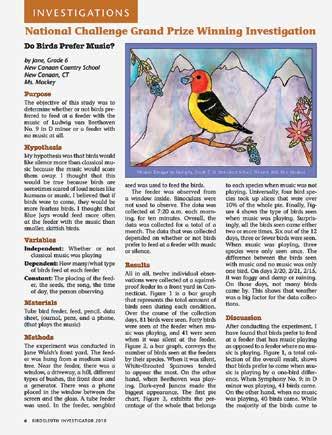

While in sixth grade, Jane undertook her experiment “Do Birds Prefer Music?” in her front yard over a month-long period and submitted it with assistance from Upper and Middle School Science Teacher Margaret Mackey. She designed an experiment to determine whether or not birds preferred a feeder with the music of Ludwig van Beethoven (Symphony No. 9 in D minor) playing nearby, or a feeder with no music at all. Her hypothesis was that birds would prefer silence and be scared away by music. To her surprise, this was not the case. She discovered that, by a small margin, birds preferred the feeder that had music playing as opposed to a feeder where no music is playing. This was especially true of the Dark-eyed Junco species.
“We were really impressed with the creativity of Jane’s discussion,” said Kelly Schaeffer, Director of Cornell University Lab of Ornithology’s K–12 program, which publishes experiments from students around the country in BirdSleuth. “Not only did she conduct a fair experiment to test her question, Jane provided thought-provoking discussion about her results and what other factors could have influenced the data collected.
We’re excited to share Jane’s investigation with other students and inspire the next batch of feeder investigations.”
For the past several years, Country School students have designed and conducted experiments on bird feeding behavior over the course of the winter. The experiments are part of a unit focused on the study of birds’ ecology and adaptation. Generally, students have tested whether birds prefer a certain color or type of seed (several experiments have been published in BirdSleuth in years past). Jane, however, wanted to do something unique.
“I took a risk investigating the effect of music on feeding habits and it paid off,” said Jane, who can identify all the birds in her neighborhood.
“Jane has sparked an interest in others,” said Ms. Mackey. “Now students want to expand upon her idea and do experiments with different kinds of sounds and music. Good science always begs new questions.”
Early in sixth grade, the class worked on an experiment together about the formation of igneous rocks to familiarize themselves with the scientific method. The bird experiment, which
happens later in the year, however, required autonomy.
“The goal of any inquiry-based project is to develop independence, close observation and time management,” said Ms. Mackey. “At every step, the students are real scientists, right until the point of publishing their findings in a scientific journal.”
Jane is proud of her accomplishment. “It’s amazing that something I did by myself in my backyard is being read by people all over the country.”
Jane Walsh and Upper and Middle School Science Teacher Margaret Mackey


was one of the driving factors for the redesign of the John-Christophe Schlesinger Library, which reopened in Fall 2018 incorporating the new Amicus Foundation Innovation Space. With almost all of the furniture on wheels and most surfaces writable, and a large central space flooded with sunlight, the ways it can be used are limited only by one’s creativity. Pass by on any given day and you are bound to see a new activity. So far this school year, it has hosted the school’s book fair, a first grade campfire sing-along, dozens of parent coffees, coding clubs, apprentice teacher training workshops, board meetings, the Horizons Saturday Academy, Homework Central, and several hundred individual class visits for math, science, languages, digital drawing, script editing, identity projects and more.

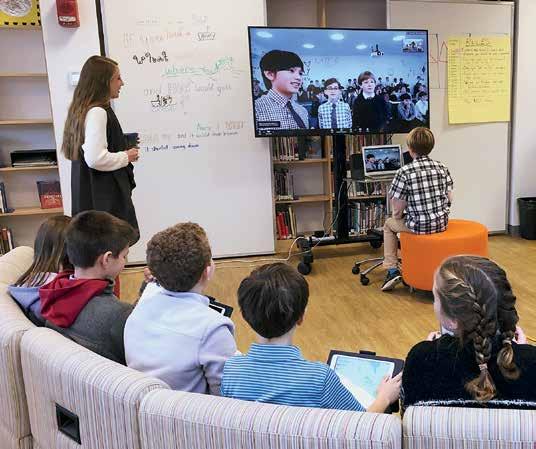
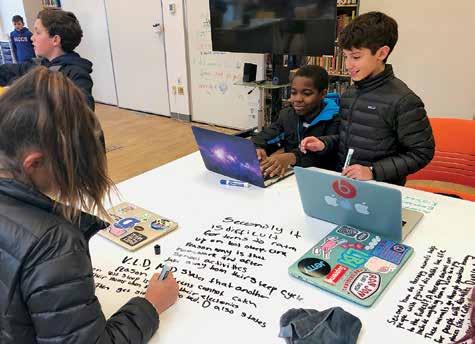

With the new Susan Haigh Carver ’51 Dining Hall & Commons complete, the next phase of the school’s long-range campus master plan calls for the construction of a new Athletics and Wellness Center to appropriately serve students at all grade levels in a PreK–9 school and to serve as an additional marquee community space.
While Country School offers a robust and developmentally appropriate PE and athletics program, the physical space is lacking. Due to this lack of space, many sports teams must travel off campus to practice, which cuts into valuable class time.
A new Athletics Center will alleviate off-campus travel and allow for increased sports options, including squash courts to accommodate growing interest. It will also provide muchneeded spectator seating so that parents, alumni and friends can come and cheer on our student athletes.
The upper-level main entrance will lead to 4 squash courts, a two-court gymnasium to serve basketball and volleyball (the two competition basketball courts can also be configured to enable four practice courts) with retractable bleachers for spectator
seating. The new complex will also include improved student and faculty locker rooms, an expanded fitness center, two multipurpose spaces for health and wellness programs as well as other program needs, sufficient storage for indoor and outdoor athletic equipment, and new facilities offices. The upper level will be accessed from the Lower School circle, while the locker rooms and lower level will open onto the athletic fields. Horizons will be building a new and improved pool closer to the Lower School.
In addition, the plan calls for reseeding and regrading all of the athletic fields, with the potential addition of a turf playing field. The baseball diamond will be relocated further south to relieve the football field and allow more space, and the east drive will be reconfigured to add convenient and dedicated parking for athletic events.
The space will accommodate the entire school community and provide a bright and open space for community events such as the Annual Meeting & Dinner, PA’s Deal Days, and academic events such as the fifth grade Medieval Faire.
Thanks to the generosity of two New Canaan Country School families, the school will acquire approximately eight acres contiguous to the school’s existing 75-acre campus.

The purchase of 579 Frogtown Road was made possible by a $1 million leadership gift from an NCCS family who wishes to remain anonymous as well as a gift from the Moore family — the current property owner and an NCCS legacy family.
“I offer my deepest thanks to the generous Country School donor family,
who wishes to remain anonymous, for making this purchase possible,” said Board President Randy Salvatore in a letter announcing the purchase to the school community.
To show appreciation and thanks for the Moore family’s gift, one of the squash courts in the new Athletics and Wellness Center will be named for the late George Moore Sr., who attended NCCS in the ’40s and was the father of Tanya Moore Jessop ’86 and George Moore Jr. ’83.
“With this significant acquisition, we will have additional opportunities to enhance existing NCCS programs and provide new programmatic opportunities in the future,” said Salvatore.
The property at 579 Frogtown Road was part of the original 150-acre property purchased by New Canaan Country School from Grace Church in 1936, but was sold shortly thereafter to the Moore family.
Country School’s physical education and athletics program provides a foundation for a lifetime of enjoyment of physical activity as well as preparation for competitive sports, both in secondary school and college. Congratulations to the following alumni on their recent college athletic achievements!




Sophomore hockey season (2018–19): Named NESCAC Women’s Ice Hockey Player of the Year, only the third sophomore named in the history of the award, and received All-America Second Team recognition among DIII players nationally. Also, All-NESCAC First Team and Winter All-Academic Team selection as league leader in points (39), goals (20) and assists (19), and ranked 10th nationally (NCAA DIII) with 1.39 points per game. Helped lead the Ephs to the top seed in the NESCAC play-offs and scored the gamewinning goal for their second ever NESCAC Championship. Also plays on the varsity lacrosse team. Secondary school: Deerfield Academy. Varsity ice hockey captain junior and senior years. Varsity lacrosse captain senior year. Varsity ice hockey Most Valuable Player (2016–17), varsity lacrosse Coaches’ Award (2017) and U.S. Lacrosse High School Academic All-American (2017). Awarded Deerfield Academy’s William B. Jaffe Award for the student who exhibited courage, leadership and sportsmanship on the athletic field.


Junior season (2018–19): Played forward for the 2018–2019

NESCAC Champions. Trinity captured its third conference crown in the last four seasons. Earned 18 points in 23 regular season games; 11 points in 14 conference games. Secondary school: The Berkshire School. Played varsity hockey and lacrosse. Won MVP Award (hockey). Also was a Senior Prefect Leader.
DARTMOUTH
Sophomore Season (2019): Plays defense for the Big Green.
Named Ivy League Defensive Player of the Week after anchoring the Dartmouth defense in a 21–2 victory over Columbia. Has started all 25 games of her Dartmouth career. Secondary school: Choate Rosemary Hall. Four-year member of the varsity lacrosse and field hockey teams and captain of both teams senior year. First-Team All-American for lacrosse as both a junior and senior. All-NEPSAC for field hockey as a junior and senior. Received the Hester C. Macquire Award for greatest contribution to athletics as a sophomore. Received the Eugenia Baker Jessup Award for greatest contribution to athletics as a junior. Received the Kennerly Memorial Award for Leadership as a graduating senior.







Sophomore season (2018): Appeared in all 18 of UVA's games, tallying 18 game points, three goals, 17 ground balls and caused 12 turnovers. Secondary school: Brunswick School. Named to the Under Armor Underclassmen New England Team, Four-year starter, two-time team captain (lacrosse). Named two-time first-team All-New England, two-time team MVP (first in school history), 2017 and 2014 New England West 1 Champions, No. 4 ranked team in the country in 2017. Also, played football as a four-year starter, two-time team captain, Team MVP (2016). Named New England Player of the Year, two-time All Housatonic League, two-time first-team All-New England (football). Honor Roll every semester. Received the 2017 Jenkins Award for best scholar athlete.

CORNELL UNIVERSITY LACROSSE


Sophomore season (2018): Honorable Mention

All-Ivy (2018). Highest scoring defenseman on the team with two goals and five assists. Scored against Penn and again vs. Yale during the Ivy League Championship game. Secondary school: A four-time letter winner for The Taft School, served as team captain twice, and led the Rhinos to the 2016 Founders League Championship. A three-time All-Western New England selection. Also won Taft’s Lance Odden Lacrosse Award, recognizing the player who has given the most to the Taft lacrosse program, as well as the Hunter Stonington Award, given to the Taft senior who has contributed most to athletics. Also, lettered four times in squash, was a twotime captain and was a two-time Founders League all-star.



Freshman season (2018): Ivy League
Rookie of the Week. Appeared in 11 games, scoring seven goals with one assist for eight points. Netted firstcareer hat trick with three goals and two ground balls in a win over Dartmouth (March 24). Ivy League honor roll. Secondary school: The Taft School. Four-year varsity letter winner for Taft, also played for the Eclipse Lacrosse Club. Named No. 35 recruit nationally. Also named 2016 and 2017 US Lacrosse All-America, All-Western New England (2016 and 2017), and Western New England Midfielder of the Year (both seasons) and USA Today second team All-America. 2016 Founders League champions. Also played for squash team at No. 1 position and captained both the lacrosse and squash teams. Honor Roll.


Senior season (2018–19): Selected for the 2019 NESCAC Women’s Squash All-Conference Team and was invited to the 2019 College Squash Association Women’s Individual National Championships. Played at the first position all season, is one of 20 athletes on the all-conference team and one of 10 voted to the second team. She leads all players on the Hamilton roster with 39 career wins. Team co-captain. Secondary school: Milton Academy. Most Improved Player (2015–16) and was the varsity squash captain senior year.




Junior season (2018–19): Plays forward for the Big Red. Captured the Eastern College Athletic Conference (ECAC) hockey regular season title, earning a spot in the Frozen Four. Season highlights included 11 assists and 7 goals, of which 2 were in the game versus Union College. Named to the ECAC All-Academic Team (2017 and 2018). Secondary school: New Canaan High School and North American Hockey Academy (three seasons) where she was a two-time Junior Women’s Hockey League All-Star. On the national stage, participated in USA Hockey’s National Camp (2012, 2013 and 2014) and was invited to the U-18 Selection Camp in 2015. Also skated for the Mid-Fairfield Stars from 2011–16 and was a USA National Championship runner-up in 2014.
Junior season (2018): Named Division III All-Region and All-NESCAC. Earned NESCAC Fall All-Academic recognition. Led the conference in goals (20) and points (44). Recorded five game-winning goals and three hat tricks. Scored multiple goals in six different games during the season. Secondary school: The Westminster School. 2016 team MVP. Class A New England Championship Runner-Up 2016. Also played lacrosse and ice hockey. Lacrosse captain, NEPSWLA Lacrosse All-Star, and a 2014 New England Ice Hockey Champion. Graduated magna cum laude.

Sophomore season (2018–19): Plays forward for the Colgate Raiders. Played in 15 games his freshman year scoring 2 goals. Sophomore season played in 19 games.


Earned Dean’s Award or Dean’s Award with Distinction for academic excellence in all terms at Colgate. Secondary school: Choate Rosemary Hall. Captain of the ice hockey and golf teams as a senior. Named to the All-Housatonic Second Team in 2015–16 and earned the Courtenay Hemenway Award for Excellence in Hockey (senior year). Played the 2016–17 season with the Alberni Valley Bulldogs of the BCHL, where he earned Most Sportsmanlike Award. Also, Editor-in-Chief of The Press.





Junior field hockey season (2018): Started all 15 games. Scored 8 goals with 1 assist. Co-captain for upcoming 2019 season. NFHCA Division III National Academic Squad. Sophomore lacrosse season (2018): Played in 18 games. Scored 13 goals and dished out 5 assists. Picked up 9 ground balls. NESCAC Runner-Up. Secondary school: Deerfield Academy. Western New England All-Star (field hockey) 2014. Four-year varsity starter on field hockey and lacrosse teams. Received the 2015 Ramsay Cup (top midfielder in lacrosse) and the 2016 Benjamin C. Haviland Award (lacrosse). Also played ice hockey. Graduated with honors.

Holly
Every Thursday morning at 10 a.m., Upper School students gather for their weekly assembly in the Alumni Commons of the Stevens Building. After a variety of announcements from students and faculty — the upcoming dance, a reminder about a test, yearbook committee requests — the room begins to hush and students shift their bodies to get comfortable and settle in. They take a break from the hectic pace of their day and listen attentively to a student or two deliver their This I Believe speeches.
Over the course of the year, every ninth grader delivers a This I Believe speech. The project has become a rite of passage and a culminating moment for the students as they begin to think of their lives beyond Country School. Much like the National Public Radio program that it emulates, the essay is a personal exploration of a student’s closely held beliefs and the principles that they are beginning to use to guide their lives. The national program was first broadcast in 1951 by renowned radio journalist Edward R. Murrow and brought back on air 50 years later in 2001. In 2009, the project was initiated at Country School in the ninth grade by former Assistant Head of School Francie Irvine.
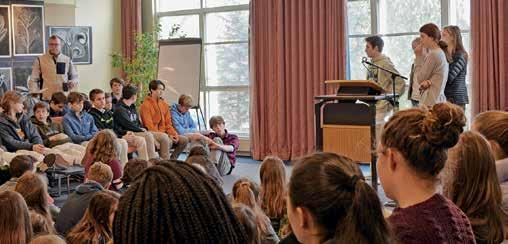
“Ninth graders are idealistic, thoughtful and interested in the world and their place in it,” said Ms. Irvine. “We thought
Upon Ms. Irvine’s retirement in 2012, the project was stewarded by former Assistant Director of Admissions Ryan Kimmet and by the late Head of Upper School Tim Delehaunty. Alumni and faculty members remember fondly how Mr. Delehaunty covered his office door with index cards containing snippets of ninth graders’ This I Believe speeches, which he then mailed to students a year after their graduation.
Students begin to write their first draft over the summer before ninth grade. They are given some guiding tips: “be specific, tell a personal story and come to a point about something you have learned about the world, yourself.” Upon their
“After a great deal of thinking, I finally decided that the idea of being yourself is overrated; it’s accepting yourself that really matters.”
—ELLIE WALKER
return to school in September, they are expected to be ready for the final editing process to begin.
“I tell them to write the speech that only they can write,” said Upper School English and History Teacher Liz Carroll, who now co-leads the This I Believe project along with her colleague English and History Teacher Tom Giggi. “I also understand that asking a 14- or 15-year-old to be vulnerable is a tall order.”
“We are asking students to say ‘This is who I am,’ and that is huge,” agreed Mr. Giggi. “It requires independent thinking, self-reflection and the confidence to share something personal with their peers.”
Ninth grader Mason Zea wrote his speech about the impact that his grandfather’s death had on him. He was reserved in early drafts of his speech, unsure of how personal and forthcoming to be in his writing. “It took a while for me to write about how he died. But I realized that it’s a big part of my story.”
Editing and revision are essential parts of the This I Believe process. “We are looking for that kernel in each student. Sometimes you don’t even see it until a couple of drafts in,” said Ms. Carroll.
Ninth grader Ellie Walker, who wrote about accepting her individuality, struggled with narrowing her focus and expressing what she wanted to say and how she wanted to say it. She spent the summer before ninth grade recording numerous audio notes on her iPhone, all relating to her view of the world. “I had so many ideas and rewrote my speech 14 times throughout the month of August. And then I edited it more when I came back to school.”
“Ellie took the project very seriously,” said Mr. Giggi, who worked closely with her as her English teacher. “She really wanted it to represent herself.”
Ellie and Mason remember sitting in the audience as seventh and eighth graders listening to the older students deliver their speeches and asking themselves: “Would my speech be as good, as powerful?”
Now that their speeches are behind them, they feel relieved and satisfied. “Time stood still while I was giving the speech,” said Mason. “And then it was one big rush.”
On Friday mornings, each classroom in the Thacher building winds its way to the center of the piazza to form a large community circle that we call Gathering. This time and place is intentionally set aside once each week for connection and sharing; a space for children to sing a song, demonstrate a fingerplay, or deliver news from the classroom or news from home. A space for the voice of the child to be heard, understood and appreciated.
As a group, the children stand alongside each other as their voices come together to sing in harmony or chant rhythmically. Individually, the child stands in the center of our community circle, confidently holding onto the microphone as their voice resonates back to them. The child speaks spontaneously, occasionally pausing, needing a breath or a prompting question from a supportive adult. Sometimes the message is brief, often it generates points of connection from the surrounding circle, and it is always genuine and reflective of the child’s priorities.
This is the beginning of the child’s knowledge of their own voice, how their words convey a message and how that message can have meaningful connection to others. It is the

“Nothing in life is guaranteed, and random events can sometimes have more impact on our lives than the things we have been planning for years.”
—MASON PRATT
“We are not following paths or in the footsteps of anyone else, but making them and shaping them so they are our own and nobody else’s.”
—ANNA SHERIDAN
powerful recognition of how their voices can come together to make music and how their voices can stand alone and inspire others. There is room for both in this safe, accepting, welcoming circle. These moments are the foundation for the thread of public speaking opportunities that weave their way through the fabric of the Country School experience.
Every Day 6, the Lower School holds a community assembly. The assemblies consist of a variety of presentations — everything from poems written by students to skits on timely topics to singing songs. On occasion, Upper School students visit to share a presentation or performance. Three fourth graders are the announcers for each assembly. As announcers, students create a script, including an opening and a closing, and determine how to best introduce each presentation. On the day of the assembly, the announcers practice with the microphone, and they inevitably discover that it’s very strange hearing your voice coming from a speaker across the room while you are still speaking! During the assembly, the announcers learn that the script might not go according to plan. A sound glitch, a forgotten line, stage fright. One must be resilient and continue. Leadership qualities are employed when the students realize it’s up to them to keep the pacing of the assembly going. In addition, as announcers, they are setting the tone for the assembly. How they introduce each presentation determines, in part, how the audience will perceive it. Through this invaluable experience the students practice stage presence, diction, creativity, leadership, resilience, time management, teamwork, and ethics, all contributing to successful public speaking.
 by Sixth Grade Homeroom Teacher Brayden Henry
by Sixth Grade Homeroom Teacher Brayden Henry
Sixth grade public speaking has developed into a cornerstone of our work in the Middle School. As part of their speech project, students are asked to select a topic of their choice. The topics reflect their developing interests and their engagement with the world around them: women’s rights, animal rights, climate change, Internet privacy. Students conduct thorough research and outline and write a speech incorporating rhetorical flourishes. They memorize their final speeches and practice their public speaking skills — pacing, using their hands, modulating their voices — often videotaping themselves and asking for teacher and peer feedback. On the big day, they dress in formal attire and deliver a 3–4 minute speech in the auditorium to a gathering of the entire Middle School and their parents.
The sense of accomplishment and pride in the room after each student returns to their seat is palpable. The time, energy, enthusiasm and growth that comes out of this experience highlights the intangible growth students make through this process. The project embodies pillars of our mission in the development of time management, enhancement of resilience and the way it engages student curiosity. The entire process builds upon students’ previous years of work as writers and readers, as well as public speakers. It has become a landmark project of the Middle School years and one that many students remember throughout their time at NCCS.
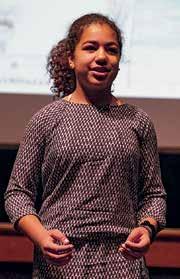 Scott Lilley
Scott Lilley
During the seventh grade Environmental Debates, which occur in February and March, students put into practice elements of what they’ve learned so far in life science and environmental science. Students are assigned a topic related to a current environmental issue involving resource use, energy production, pollution or ecology and must argue for or
against it. They research, prepare remarks and participate in a formal debate (with time limits, moderator and peer judges) against opponents who have been researching the other side of the issue. Topics have included the reintroduction of gray wolves back into the northeast, drilling for oil in the Arctic National Wildlife Refuge, viability of wind power as an alternative energy source, pros and cons of industrial logging, use of pesticides in agriculture, nuclear power, hydrofracking, the pros and cons of aquaculture, and use of coal.
The rebuttal section of the debate is one of the more challenging parts of the project. We ask students to think critically about their topic to understand why there are supporters of each side of their issue in the real world, and then to use that knowledge to anticipate the points of their opponents in the debate. The goal is to have them plan ahead and use the information they’ve gathered to disagree respectfully and with supporting detail.
In the end, this project is a practice for students in research, persuasive writing and public speaking, within the context of understanding several real-world issues in environmental science. It’s a way for them to pull together many of the things they’ve learned so far in science, and to build on all of the public speaking opportunities they’ve had in previous years in all of their classes. And we are impressed year after year with how well they rise to the challenge.


Each February, eighth grade students begin the Country School tradition of telling stories. The project — an element of the English curriculum — begins with each student selecting a folktale from a non-western culture. Students then bring the story to life, memorizing parts, animating others with hand and body movements, while also embracing the ability to improvise and take a sense of ownership for their chosen stories. Laconia Therrio, a professional storyteller who has been assisting NCCS students in this regard for the past 19 years, provides strategies and techniques used in effective storytelling during a series of workshops. The final challenge involves presenting the story to an actual audience: students from the Early Childhood, Lower, and Middle School divisions.
Throughout the process, students develop an appreciation for the value of wisdom passed down by elders through oral tradition. It reminds them of the generations who have come before them who have wisdom to share; it also awakens them to their own responsibility as that older generation. Now, it’s the younger students at NCCS who can reflect upon the morals and lessons of their stories. The accomplishment is one that invites students to take risks, but it also gives them the opportunity to improvise on the spot and to command the attention of the room. It is a rite of passage in the Upper School and a true testament to the power of our stories.
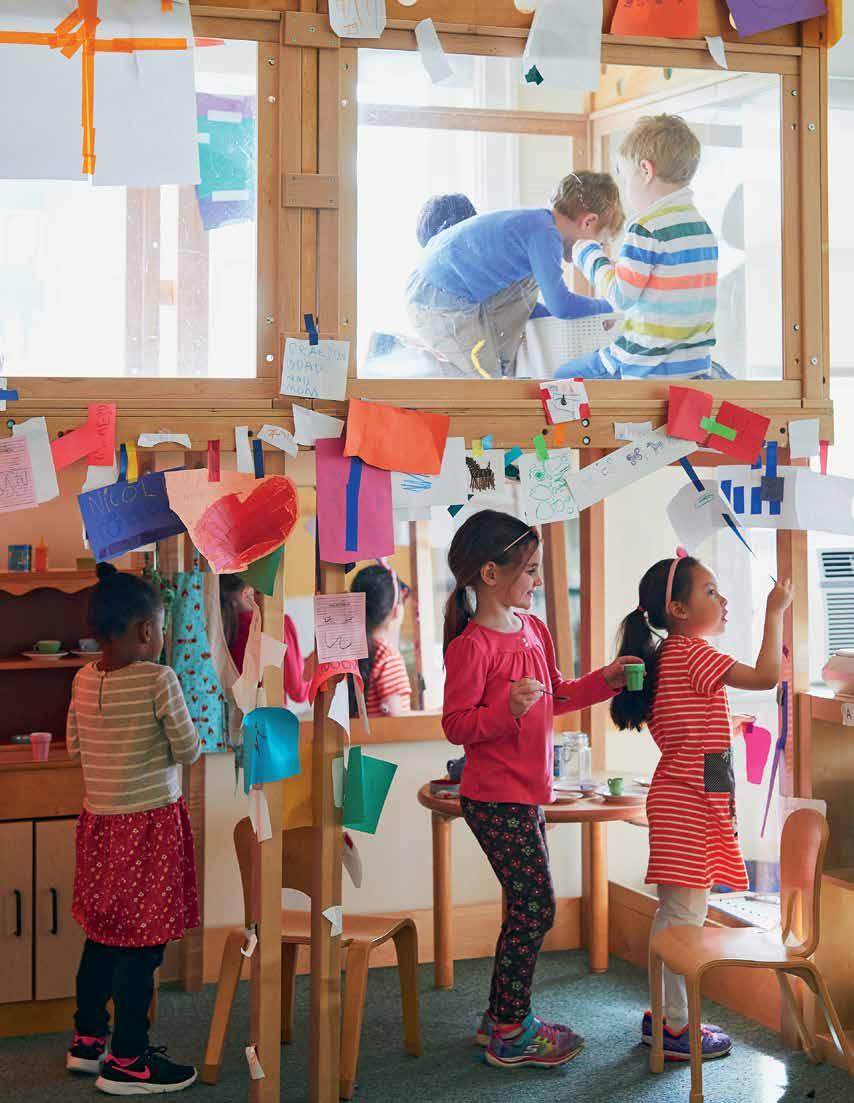
“We are intentional about looking at every child and whether they are getting what they need from our general program and if not, then we try to build a plan. We are looking very carefully not for good or bad, right or wrong, but opportunities for growth.”
—Rebecca Comizio, School Psychologist
While a commitment to teaching character has been a hallmark of a Country School education (and that of many independent schools) for over a century, it is really only in the past 20 years that schools have begun explicitly incorporating social-emotional skills into their curricula, and research in the area has really exploded.
The Collaborative for Academic, Social and Emotional Learning (CASEL), which was and still is a leading think tank on socialemotional learning, was formed in 1994, and Dan Goleman’s groundbreaking book, Emotional Intelligence, was published the following year. The Yale Center for Emotional Intelligence, directed by Marc Brackett, opened shortly thereafter. Today, most schools across the country are beginning to incorporate more formalized social-emotional curriculum, such as the RULER (Recognizing, Understanding, Labeling, Expressing and Regulating emotions) system, in which NCCS faculty were trained during workshops with Mr. Brackett in 2015.
At its core, the concept of social-emotional learning (SEL) is simple: All humans are both thinking and feeling beings. Students can’t check their emotions at the door any more than they can check their brains, and they need to build their emotional acumen as intentionally as their intellect.
“These are not ‘extracurricular’ or ‘soft’ skills,” says Country School Psychologist Rebecca Comizio. “Good, strong SEL can become the foundation of good character, academic achievement, relationship health and general well-being.”
School is the perfect environment for children to learn these skills since it is social by its very design. A curriculum that emphasizes social-emotional learning does two things: 1) it gives students specific skills that make them more successful in relating to others, and 2) it teaches them how to manage their emotions so that they are more available for academic learning.
Even with these new frameworks, the idea of social-emotional learning can still feel mushy. It is not as easy to spot with the untrained eye as — for example — a typical math lesson. While some instructional time is devoted explicitly to SEL lessons, such as life skills classes, more often teachers are incorporating SEL skills into other lesson plans. For example, a trip to the woods to learn about the lifecycle of a frog also provides an opportunity for children to practice taking turns.
If you take a deeper look at that math lesson, you might see more than just complex fractions. You would see two peers working together to practice perspective-taking, relationshipbuilding, compromise, flexible problem-solving, metacognition (thinking about thinking) and self-awareness (perhaps knowing when they might need to take a break). You will see them wrestling with the feeling of “I know this is supposed to be hard, but it feels almost impossible,” better known as resilience.
Their teacher, in this scenario, would be actively seeking opportunities to differentiate the work based not just on which particular math skills or concepts each student needed to acquire, but also to help each student figure out how he or she learns best. For some students, that may mean asking for more challenging problems, and for others it may be taking the initiative to get up and take a drink of water or sit on a wobble stool in order to improve performance.
Teachers use positive psychology to reinforce actions they want to see more of by using specific praise. For example, a teacher might stop by the small table where our hypothetical math class duo is working and say, “I like the way you got all your materials organized when I gave directions” or “I noticed that you listened to your partner and came to a mutual decision.”
Dig a layer deeper and wider, and you will see that there is an infrastructure of support that cuts across all divisions and all disciplines, across the entire school campus. With nearly 600 students and just two school counselors, Mrs. Comizio and School Counselor Nora Goddard are continuously thinking about how to best reach every student. They use a three-tiered, evidence-based system of support, and partner heavily with faculty and staff.
The first level of the three tiers (think of the base of a pyramid) includes universal supports or practices that answer the question: “What does everyone need?” These include well-trained teachers, classroom environments set up to optimize learning, division-wide frameworks for classroom management such as Responsive Classroom and RULER, as well as dedicated time for explicit instruction in SEL skills, such as morning meetings, homeroom, advisory and life skills classes. Sports and recess also provide ample training ground for building interpersonal skills.
At the beginning of each school year, classroom culture is set with intention through team-building activities such as the seventh grade “Finding Stevens” orientation and the ninth grade Outdoor Action Trip, and through the creation of classroom agreements or classroom charters that answer “How do we want to feel at school?” and “How do we want to be treated?”
Tier 1 also includes the daily schedule designed to allow for times of socialization and promotion of healthy social dynamics. Lunch, clubs, sports, recess and assemblies all create opportunities for students to connect with new people in different ways.
Perhaps the most powerful tool in Tier 1 is teaching kids about the science behind their own thinking and feeling.
“When kids understand the ‘why’ it is always more empowering,” says Mrs. Comizio. She teaches children as young as age three about the different functions of their brains using age-appropriate language and nicknames for the parts of the brain such as Myg (short for amygdala), the Professor and Ms. Hipp, the librarian. “And I can tell the students a story that helps them understand.” Throughout the course of the year, all students in Grades 1–4 are invited to attend an informal lunch with Mrs. Comizio, in a group of 10 or so students, which she has dubbed “Mrs. C’s Chats.”
“It’s so important for kids to make the connection of how a feeling feels in their body,” says Mrs. Comizio. “I teach them that a feeling in your brain lasts for 90 seconds and it is normal! That basic understanding is so helpful. It can take the shame, blame and guilt away from what they are naturally feeling.”
“For the older kids, the scientific knowledge supports destigmatization and also helps them understand what is actually happening in their bodies,” says Ms. Goddard. “They can ask themselves, ‘Why am I shutting down?’ I teach them that our amygdalas are always scanning when we feel in danger, and we can ask ourselves, ‘How can I bring my prefrontal cortex back and put strategies into practice?’ This helps kids to respond. I want to teach them strategies that put them in the driver’s seat. They can go get a drink of water or take a deep breath and change the chemistry in their bodies.”
Once a month, Ms. Goddard teaches a 45-minute lesson in each fifth and sixth grade classroom on topics such as the science of the brain, stress management and emotion regulation, cognitive flexibility and appropriate social media use.
• Self-awareness: Know your strengths and limitations, with a well-grounded sense of confidence, optimism and a “growth mindset.”
• Self-management: Effectively manage stress, control impulses, and motivate yourself to set and achieve goals.
• Social awareness: Understand the perspectives of others and empathize with them, including those from diverse backgrounds and cultures.
• Relationship skills: Communicate clearly, listen well, cooperate with others, resist inappropriate social pressure, negotiate conflict constructively, and seek and offer help when needed.
• Responsible decision-making: Make constructive choices about personal behavior and social interactions based on ethical standards, safety and social norms.
In the middle of the pyramid, Tier 2 answers “What do some students need?” As social-emotional challenges come up, as they naturally will as children grow, there are no hard-and-fast easy answers or a perfectly packaged kit of lesson plans. So, Ms. Goddard and Mrs. Comizio partner with teachers to create unique lesson plans.
For example, when Second Grade Teacher Sue DeOreo noticed that her students were having trouble bringing their full attention and focus throughout the day, she and Mrs. Comizio developed a plan to teach the second graders the skill of self-monitoring, a form of mindfulness.

Together they developed a simple “Best Self-Monitoring Chart,” which had a three-question checklist for the second graders: “Do I know the directions? Am I doing that thing?
Am I respecting the learning of others?”
Mrs. Comizio joined the class one morning to introduce the chart and empower the students by teaching them the skill of noticing.
“The more you notice where your mind is, the more easily you can bring it back,” she told the students.

Mrs. DeOreo set a timer and whenever it rang, they would stop what they were doing and mark their check-in sheets. The students loved that it was a game, and Mrs. DeOreo noticed a significant improvement in their ability to quickly shift their attention.
Sometimes a Tier 2 support is proactive, such as the work Ms. Goddard has been doing recently with sixth grade girls. Research shows that girls are typically prone to a drop in self-confidence around age 12. In order to defend against
this, Ms. Goddard and sixth grade teachers developed a plan to give the girls specific tools to develop healthy body images, navigate friend shifts, increase connections across the grade, practice problem-solving with a friend, read non-verbal cues and use social media appropriately.
“Explicit teaching of SEL skills in small groups provides students a safe space to explore complex topics, to ask difficult questions, and to learn about themselves,” said Ms. Goddard.
In another grade, Mrs. Comizio invited a group of boys who were feeling pressure to conform to a stereotype of being “sporty” to hear from an older boy who had experience navigating that particular situation a few years prior. Not only did it help the younger boys, it also boosted the older student’s confidence.
This fall, Ms. Goddard was tapped to help set a productive tone for this year’s ninth grade. She and the ninth grade teachers guided the students in a visioning exercise, asking them to picture themselves at Closing Exercises and how they would want to feel

about their contributions to the community by the end of the year. Through this reflection, the students were able to identify a feeling of gender division in the grade, and Ms. Goddard was able to develop programming to educate them on gender norms and to help them understand how stereotypes might be impacting their collective ability to move their community forward together.
Finally, Tier 3 offers individualization. Often this targets a behavioral plan for a particular student, and includes partnership with parents, teachers and any outside supports.

“All behavior is communication,” says Mrs. Comizio. “We are intentional about looking at all the children and whether they are getting what they need from our general program and if not, then we try to build a plan. We look really carefully, not for good or bad, right or wrong, but opportunities for growth.”
There are hundreds of ways that Mrs. Comizio and Ms. Goddard can approach an individual student’s needs. One tool Mrs. Comizio shares with teachers and parents alike is the concept of the social story. Throughout the past two school years, she has trained several Early Childhood teachers on how to use this tool to help students with a number of specific social-emotional skills.
The Christen O’Donnell ’01 Memorial Fund, established in 2004 in memory of Christen who lost her life following her sixth grade year at Country School, honors her care and concern for others by supporting Middle School social development initiatives.To create a social story, teachers, in collaboration with parents make a book that depicts the child in his or her current state of feeling “stuck” and tells a story about how that child can gain the skills needed to get “unstuck”. For example, a social story might help show a child how to be a good friend or how to be flexible to the group’s needs. The goal is to have the child actually see himself or herself in the story and the steps he or she can take to move forward. Through revisitation of that story, the adults reinforce the messaging.
The idea behind this technique, as with so many others that Mrs. Comizio and Ms. Goddard use and train others to use, is that children are capable of learning with the proper amount of scaffolding, practice and encouragement.
At a Parents’ Association “Parent Talk” this fall, Head of School Aaron Cooper spoke about the “zone of proximal development” — that sweet spot where children feel challenged to stretch for something that might feel just at the far edge of their comfort zones. Even in the younger grades, some level of struggle (academically, physically and social-emotionally) is healthy. It’s important to let children feel some frustration while learning a new task, like cutting with scissors or tying their shoes. Struggling to sound out words or write a research paper, or even wrestling with the feeling of being bored, are all important for children.
“The stress kids feel when they don’t know what to do at recess, or what group they might join, is normal and healthy. If we take away all disagreement, we are not actually preparing our kids for real life,” says Mrs. Comizio.
Known as “the feelings teacher” to her Early Childhood and Lower School students, Mrs. Comizio is our School Psychologist working with our students in Beginners through Grade 5. She holds a B.S. in Secondary English Education and Philosophy from Central Connecticut State University, an M.A. in Philosophy and Education from Columbia University, and an M.A. in School Psychology from Iona College. She also works as an independent contractor for The Waverly Group, counseling children, adolescents and parents. She runs the School PsychEd Podcast with two other school psychologists, a podcast by school psychologists for school psychologists, and her @yourschoolpsychologist has almost 50,000 followers on Facebook. Mrs. Comizio is Chair of the National Association of School Psychologists’ Communications Committee, a NASP Leader and coauthor of 70 Play Activities for Better Thinking, SelfRegulation, Learning & Behavior.

Ms. Goddard is our School Counselor, primarily serving Grades 5 through 9. Most recently, she was Director of Admission and Next Schools Guidance Counselor at The Advent School, an independent pre-Kindergarten–Grade 6 school in Boston, MA. Ms. Goddard holds a B.A. in Psychology from Hamilton College and an M.A. in School Counseling of Education from Boston College.

Over the course of this school year, Director, Diversity & Inclusion Kisha Palmer has been focused on giving the entire faculty and staff the knowledge, tools and resources to create an inclusive school community where all children and adults are valued.
“Diversity and inclusion is the work of the entire school, not just one person,” said Head of School Aaron Cooper. “Kisha’s role is to be a trainer and coach. By engaging everyone in this effort, we help to ensure its long-term sustainability.”
Ms. Palmer has been working as a consultant since fall 2018 and is on campus one week a month. She’s been leading faculty and staff professional development sessions to build a solid foundation, which will be built upon by the new full-time
Director of Diversity, Equity and Inclusion Kojo Clarke, who will start in July 2019 (see page 39).
“In order to really dig into diversity and inclusion in the school’s operations, culture and curriculum, we need a shared vocabulary,” said Ms. Palmer. “Talking about identity, biases and privilege takes practice and requires trust and understanding. My goal is to create a safe space where people can talk about uncomfortable topics. It may be messy, but we have to take risks and have these conversations even if we are afraid.
Ms. Palmer stresses the importance of equity in independent schools. “Inclusion without equity is only half the journey. I encourage schools to ask themselves whether are they are providing an environment where every child can participate fully and succeed to their potential. And if not, why?”
Ms. Palmer has also been working in smaller groups with grade level or divisional teams to employ the widely-used Teaching Tolerance program. A project of the Southern Poverty Law Center, Teaching Tolerance provides a set of resources to develop curriculum and inform educational practices that foster inclusivity in schools.
As part of the effort to make diversity, equity and inclusion part of the school’s overall fabric, a Diversity Liaisons group was created with one representative from each of the schools’

Faculty participation in the People of Color Conference and student participation in the Student Diversity Leadership Conference was made possible in part by resources from the
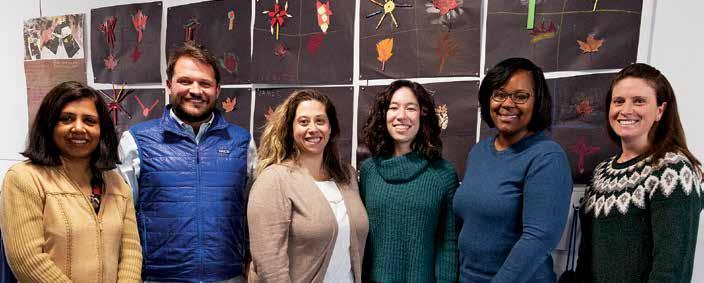
Six ninth graders and 10 faculty and staff members traveled to Nashville, TN, for the annual Student Diversity Leadership Conference (SDLC) Nov. 28–Dec. 1, 2018. This year’s conference, “Listening for the Grace Note: Finding Harmony Amid Cacophony,” a nod to the country music capital and host city, was attended by 1,600 ninth through 12th graders from all over the country. Students heard from Lisa Ling, a well-known CNN producer, and Christian Picciolini, an anti-racism activist. Students worked with trained facilitators to learn cross-cultural communication skills; they spent time in affinity groups and brainstormed ways to improve their school communities.

divisions, the staff and Horizons. Much of the group’s role revolves around peer leadership, facilitation and support. The Diversity Liaisons have worked closely with Ms. Palmer to serve as resources for their colleagues. They have begun leading group discussions in their respective divisions and departments, shifting the professional development to more intimate settings in the divisions and addressing pointed concerns.
At the end of November, the school sent the largest cohort in recent history to the People of Color Conference, the independent school conference for leadership development in diversity and inclusion. Ten members of the faculty and staff attended the conference, which ran alongside the Student Diversity Leadership Conference in Nashville, TN. They heard from wellknown speakers, participated in affinity groups, and networked with people of color and allies of all backgrounds. They later shared their experiences and insights at a full faculty and staff professional development session.
Hannah Liu, an Upper School Latin Teacher and Diversity Liaison, is witnessing a shift in her division. Ms. Liu says that teachers in her division have sought her out to ask questions about a lesson or discuss a student’s needs.
“Talking about these issues has become much easier. Because of the group reflections, discussion and trainings, there is more of a growth mindset in the faculty around diversity and inclusion.”
Country School completed a search for a new Director of Diversity, Equity and Inclusion this winter. Equity was added to the title with the knowledge that we are building the capacity in our community to understand the way systems, context and perspective impact experience.
(See page 39 for information about Kojo Clarke, the new Director.)
“My goal is to create a safe space where people can talk about uncomfortable topics.”
—Kisha Palmer, Director, Diversity and Inclusionby Will McDonough, Co-Director of Service Learning
would be easy to organize the ways we spend our time into two categories: things we have to do, and things we choose to do. Yet there is a third category of things that are not required of us, but that we feel compelled to do simply because they are right.
These actions, and the decisions that lead to them, stem from what I like to call the Miss Rumphius effect. Of course, many of us recall the story of Miss Rumphius, a treasured tale by Barbara Cooney, and a hallmark of a Country School student’s experience in the Lower School. The story follows a little girl who admires her Great Aunt, Alice Rumphius, a wise old woman who passes along the challenge her father gave to her: to discover how she, herself, can make the world more beautiful.
And, ultimately, isn’t that our greatest wish for our children? That along with being happy and healthy and fulfilled, they will grow into young adults who think beyond themselves and feel compelled to do something to make the world a better and more beautiful place.
Our mission ends with the maxim “New Canaan Country School inspires students to be lifelong learners with the courage and confidence to make a positive contribution in the world.” So, how do we — as partners in the growth of our children — do it?
Well, we do it in many ways, but one of them is through the spiral curriculum of our service learning program. The term
“spiral curriculum” is rooted in cognitive theory advanced by Jerome Bruner (1960) who used the term to describe a course of study in which students will see the same topics throughout their school careers, with each encounter increasing in complexity and reinforcing previous learning.
These encounters of increasing complexity are the ways our students become aware of the world around them, and are apparent as their questions grow from Who? and When? and What? to Why? and What if? and Now what?
One rich example of such a curricular element is Country School’s relationship with Person-to-Person (P2P), a Darienbased organization born out of the pain surrounding the assassination of Dr. Martin Luther King, Jr. in 1968 and committed to using resources to help those in need in the greater Stamford and Norwalk communities.

At Country School, our students’ first exposure to the organization comes in first grade, during a visit to the Personto-Person headquarters as they study community. The unit culminates with the entire grade writing and performing a skit about various services to the community.

Next comes an on-campus visit from Phil the Truck, Person-to-Person’s mobile truck that helps address the food-related needs in Stamford, a city where 12% of the population identifies as food insecure.
This year marked Phil the Truck’s first visit to the Country School campus, but it assuredly will not be its last. As each student walked through the truck, they saw a full selection of
grocery items including fresh fruits and vegetables, dairy, meat, grains and shelf-stable goods. As one second grader noted, “Phil the Truck is like a mini supermarket.”
Students also learned that the truck allows Person-to-Person to reach 40 families daily, providing enough food for three meals a day for seven days. Having a caseworker on board also gives people in the community local access to counseling services and emergency financial assistance. The impact of the truck’s accessibility did not go unnoticed as another second grader acknowledged the reality that “Person-to-Person is an amazing organization because no one is ever turned away.”

The school’s partnership with the organization continues in the Middle and Upper School divisions through events held during the Kyle A. Markes Day of Service in April, as well as with the annual Dove program in support of New Canaan Social Services. For over 40 years, the program has been providing winter holiday meals for 800+ families in the New Canaan community who find themselves unable to provide a holiday meal for themselves. Each Middle School homeroom and Upper School advisory collects food, providing a special meal for two families.
As Person-to-Person’s Executive Director Ceci Maher puts it, “P2P’s connection with NCCS is long term, caring and committed. We remain so grateful for the years spent working together with NCCS to help those most in need of support. The natural kindness of NCCS families shines through as we work alongside the children; thank you for this important relationship.”
During a Lower School assembly, one student shared how classroom discussion included the importance of recognizing “why people may need help from Person-to-Person. We talked about how hard it could be to take care of yourself or your family for many different reasons. Maybe someone lost their job, or they are sick, or maybe they don’t have family and friends nearby to help.” The importance here being an acknowledgment of our own susceptibility to changing circumstances and needs that are out of our control.
Through the school’s spiraling relationship with Personto-Person, students are kept attuned to the work of the

That along with being happy and healthy and fulfilled, they will grow into young adults who think beyond themselves and feel compelled to do something to make the world a better and more beautiful place.”
organization throughout their Country School journey. In fact, each year there are surprising, student-driven ways that the organization appears as well. Whether it is during a sixth grade speech about food insecurity or during the eighth grade World Congress Human Rights Task Force presentation about solutions to hunger, our students understand the impact because it has been embedded, both directly and indirectly, in their experience. This is merely the beginning of each student’s journey. What we hope is that they will begin to see the organization as an exemplar of the impact one person can have on another. If we can model this initiative and impact for our students, they will feel compelled, just like Miss Rumphius was, to do something for others, and through doing so, they will develop the courage and confidence to do great things for the world around them.
“And, ultimately, isn’t that our greatest wish for our children?
PA Executive Council
Tara Coniglio, President
Susan Barr, President-elect
Marcy Smith, Treasurer
Liz Keogh, Secretary
Leigh Kennedy, VP, Community Service
Michelle Saldivar, VP, Community, Diversity and Inclusion
Marnie Gizzie, VP, Volunteers
• Admission Ambassadors
• Annual Fund Ambassadors
• Annual Meeting & Dinner
• Campus Beautification
• Class Representative Program
• Community Service
• Cougar Run
• Deal Days
• Faculty & Staff Appreciation Day
• Family Fun Night
• Festival of Books
• Frogtown Fair
• Greenery
• Host Family Program
• Kyle A. Markes Day of Service
• Logo — NCCS Spirit Wear
• Nominating & Appointments
• PA Coffees
• PA Committee & Volunteer Fair
• Parent Gatherings
• Parent Talk
• PJs & Pizza
• Resource Groups: Allergy, Global Citizens, Mothers at Work, Parents of Students of Color
• Upper School Dinners: Celebration of Girls, Celebration of Boys
We hosted community-building events, held fundraisers, launched our Parent Talk series and participated in community service projects. We are fortunate to have such a kind and engaged community and we are grateful for the support of the parents.

A special thank you to Allison Ryan for creating our new Parents’ Association logo!
This past summer, the Grace House renovations provided a beautiful new space for the Parents’ Association School Store. The store is now centrally located between the lobby and Carver Commons, and offers spirit wear for all ages. The merchandise is sourced and the store is managed by parent volunteers. All funds raised from spirit wear sales are donated to NCCS to support school programs.

The Parents’ Association had an exciting start to the 2018–2019 school year.
On Saturday, September 28, the Country School community gathered for the first annual Cougar Run. More than 120 runners completed the 5K on-campus run, and young children participated in an obstacle course and a Chase the Cougar Fun Run. Families gathered on this beautiful, sunny, fall morning to cheer on runners and to kick off the school year. Attendees showed their school spirit and purchased spirit wear. Our school mascot, the Cougar, was a favorite guest of the morning. Our very own NCCS cross-country team helped design the course and led the way for the runners with the assistance of Head of School Aaron Cooper.
1. Our community takes off from the starting line of the Cougar Run.

2. Upper School students Mason Zea, Amitav Nott, Benjamin Herdeg, Rett Zeigler, Annika Mannix, Ashley Rodgers and Maren Frey, enjoy the pre-race activities together.


3. Barrett Hanson and Lucy Anne Kurtz help with the logo sale.
4. Luna Robb, Sean Robb, Oliver Johnson, James DiBiasio, Lucy Anne Kurtz, Ella Kurtz, Amitav Nott, Julia Cooper and Head of School Aaron Cooper gather to celebrate their win.
(Not pictured: Lindsay Frey)
5. Andy, Caroline, Galyn and Emma Bernard enjoy family time at the run.
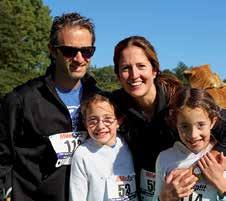


6. Luna Robb, Lily and Olivia (Liv) Burnes, Salman Memon, Julia Coniglio and Jonathan Gavidia jump into the spirit with our beloved Cougar.

7. Cougar Run organizers Steve Petricone, Jennifer Kurtz, Kerry Hanson and Laura Cramer joined Head of School Aaron Cooper to cheer on runners.
8. Charlotte Parker, Eva Mackenzie and Olivia Parker celebrate their run.






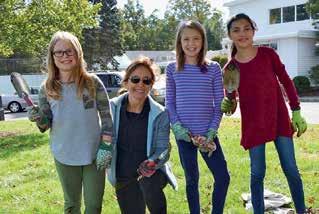

This year’s Festival of Books was a three-day celebration of literacy at Country School. It was held in the recently renovated Schlesinger Library/Amicus Foundation Innovation Space. One of the Parents’ Association’s largest fundraisers of the year, the Festival of Books also provided many opportunities to build community, as well as classroom libraries. Children in Lower School and Middle School visited the festival with their classes.

One of the favorite events during the festival again this year was “PJs & Pizza,” which brought together Lower School and Horizons students for a fun night of pizza, games, crafts and bingo hosted by John Hastings! Students then heard stories by mystery readers Emily Anglund-Nellen, Raphe Elkind, Melissa Fryer and Aman Samra ’11.
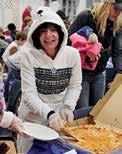

1. Berkley Young enjoying a book selection while browsing the FOB.
2. Raphe Elkind reading to a mesmerized audience of students.
3. Horizons student Kyle Foster enjoys a story in his cozy PJs.
4. Executive Director of Horizons Nancy von Euler fully in the spirit of the evening at PJs & Pizza.
5. Joaquin Vanden Heuvel finds an engaging read.

6. Tyler Rosolen, Caleb Seiden, Ryland Strine, Garrett Cannon and Ethan Schubert volunteering at PJs & Pizza.
7. Festival of Books Chairs Becky Palmer, Jen Kline and Lauren Ryder ready for the crowd to arrive.
8. Hilary Flanagan, Horizons Family and Program Director Nehemie Moise and Nicole Intile led an NCCS & Horizons favorite event, PJs & Pizza.

9. Suzie Jellinek and Jenn McDonnell scooped up great new titles at the Festival of Books.


10. Our mystery readers Raphe Elkind, Emily Anglund-Nellen, Melissa Fryer and Aman Samra ’11 all dressed up and ready to surprise their audience.
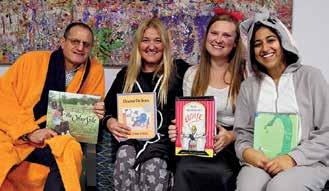
11. John Hastings led a spirited group of students in a festive round of Bingo.

12. Bingo! Ramses Perez shares his winning numbers.
1. Class Representatives gathered to plan events for the school year.
2. Anthony Coniglio, Jill Gordon, Dan Malkoun and Shannon Kieske kicked off the school year at the Parents’ Association opening day coffee.
3. Ellie Levinson, Leigh Kennedy, Daley Keogh and Madeline Maliakal planted bulbs in front of Grace House.
4. Marisa DiBiasio and Shannon Kieske connected at the PA Volunteer & Committee Fair.
5. Sue Mackey, Samara Bilden, Cindy Havens and Jaime Behr shopped at the opening day Logo Sale.

6. Taryn Jones Laeben ’95, Heidi Locke Simon, Prachi Narayan, Kara Cooper, Tucker Hackett, Jenny Harrington, Mari Lannamann, Michelle Saldivar, Jennifer Roberti, Cristina Soto, Gloria Schell, Laura Pollock and Nuria Guardado shared brunch together at the Mothers at Work (MAWs) fall potluck.

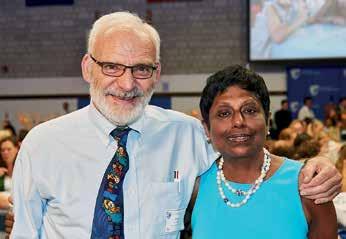
Country School celebrated excellence in teaching by naming three faculty chairs at the school’s Annual Meeting & Dinner on Sept. 13. Awarded every two years, faculty chairs have been endowed by three former Country School families to recognize exceptional full-time faculty who demonstrate a commitment to engaging and inspiring students, creating curriculum to reach all learners, and seeking ongoing professional development. They also provide financial support for growth in academic research, teaching or service.
Middle School Spanish Teacher Abby Cali was awarded the Holmes Family Faculty Chair, established in 2008 by Max Holmes, P’10, P’11 and P’13.
Kindergarten Teacher Darby Webber was awarded the Laverack Family Faculty Chair, established in 2008 by Cory and Bill Laverack, former President of the Board of Trustees P’03, P’07, P’08 and P’11.
Upper School Science Teacher Scott Lilley was awarded the Williams Family Faculty Chair, established in 2008 by Joanna and Robert Williams, P ’14.
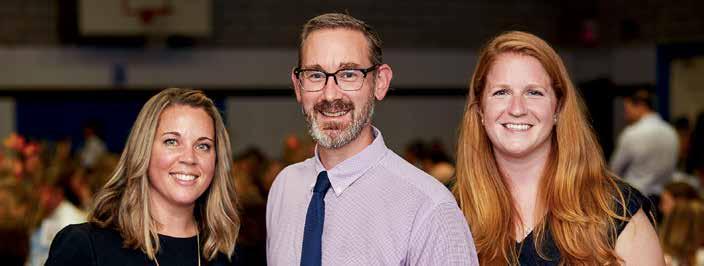
Read
The following faculty and staff were honored for their service to the school:
30 years — Lilani Balasuriya, First Grade Teacher
30 years — Fraser Randolph, Sixth Grade Teacher
20 years — Scott Lilley, Upper School Science Teacher and Advisor
10 years — Kathy Diomede, School Nurse
10 years — Sanj Maliakal, Upper School Science Teacher and Advisor
10 years — Dara Webster, Math Department Co-Chair and Lower School Learning Resources Teacher
“Latin is a zombie language. It just keeps coming back to life,” jokes Hannah Liu, the infectiously energetic Upper School World Language Teacher.

“I love how studying Latin can be a gateway to understanding an entire ancient civilization. It’s fascinating how much it can teach us about people, places and things — both past and present. My primary goal is to guide my students along that journey, and of course, for it to be fun along the way.”
Ms. Liu’s seventh through ninth grade students are familiar with her highly experiential, often quirky, lesson plans. If you thought it was all verb conjugations and translations, you would need to think again. Ms. Liu is well known for her game show quizzes and toga-clad, Legionnaire warrior sword fights.
Originally, she had considered making a career in museum education, thinking that she would share her keen interest in archeological artifacts. During her studies and following graduation from Brown University, she pursued opportunities at the Haffenreffer Museum of Anthropology, the Newark Museum and the American Academy in Rome, where she handled and helped make accessible various antiquities such as collections of rare ancient coins.
Museum life, however, is a quieter existence than Ms. Liu’s gregarious personality could take long term. She also yearned to expand her reach, make an impact on a greater number of children and put into practice some teaching techniques she had been designing. “I knew what type of educator I wanted to be, I just had to find the right environment; one where I could really interact with the curriculum and the students.”
Ms. Liu found her way to Country School in 2016.
Since her arrival, she has assimilated seamlessly into the fabric of both the school and the greater community. On campus, in addition to teaching five sections of Latin, Ms. Liu is a seventh grade advisor, the Upper School diversity and inclusion liaison, one of two faculty representatives on the Board of Trustees and a soprano in the faculty chorus.
Off campus, she is the resident tutor for New Canaan’s A Better Chance program. One of three adults living full-time in what many refer to as the “ABC House” in downtown New Canaan, Ms. Liu acts as a mentor, advisor, tutor and friend to the teenage residents who attend New Canaan High School by day. “These are very high achieving students whose home
communities can’t meet their needs academically,” explains Ms. Liu. “So, they live in this sort of boarding school situation and I am there to help them succeed.”
Ms. Liu also enjoys playing violin and piano. She swears allegiance to the Mets, attending games when she can, with her father. Previously, she had been a dancer, studying ballet and modern in high school, but has since made peace with those dreams. On weekends, she likes to browse bookstores and coffee shops (bonus points if they are combined), and volunteers in the used bookstore at Stamford’s Ferguson Library. Passionate about travel, Ms. Liu has recently spent time in Italy and Taiwan, visiting family and rejuvenating her curiosity for ancient cultures and her enthusiasm for educating teenagers.
“I love this age group; the students are so excited to participate in their learning. It’s amazingly rewarding to see them discover where they fit in to a larger world that they are just beginning to understand. Plus it’s a lot of fun,” says Ms. Liu with a broad grin.
“It’s amazingly rewarding to see them discover where they fit in to a larger world that they are just beginning to understand. Plus it’s a lot of fun!”

We were thrilled to welcome 28 former faculty and staff colleagues back to our campus Oct. 10. Honored returnees included: Eleanor Christensen, Lyn Bremer Chivvis ’60, Chris and Eric Garrison, Anneliese Gastrich, Twee Haffner, Betsy Hulme, Francie Irvine and Andrew McLaren, Sue Isaacs, Sarah Lauture, Holly Lemoine, Kate Lowe, Catherine Mishkin, Pamela Crawford Mosenthal, Jean O’Dell, Al Perry, Topsy Post ’66, Bridget Robustelli, Nick Thacher, Pam Simpson, Pat Stoddard, Lynn Sullivan, Matt Taylor, Reinhold Wappler, Marsha and Frank Whitman and John and Nancy Ziac.
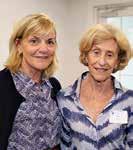




Head of School Aaron Cooper updated the group on the state of the school and recent campus renovations, answered questions and then turned them over to Facilities Director Ed Kirk, who provided a behind-the-scenes tour of the Grace House and Susan Haigh Carver ’51 Dining Hall & Commons. After this, many chose to visit classrooms and see the refurbished spaces in the academic buildings. The group came back together to join colleagues for a traditional Wednesday “Fac-Staff Lunch,” finishing the day with a performance by the 2018–2019 Faculty Staff Choir.
1. Chris Garrison, Betsy Hulme and Jean O’Dell
2. Bridget Robustelli and Al Perry
3. Matt Taylor and Horizons’ Ginny Pracilio
4. Topsy Post ’66, Pam Simpson and Catherine Mishkin

5. Francie Irvine and Chris Garrison
6. Holly Lemoine and Chris Garrison
7. Former Faculty and Staff mingled in the new Carver Commons
8. Reinhold Wappler and Karen Wappler



 9. Val Schirmer welcomes back Sue Isaacs
9. Val Schirmer welcomes back Sue Isaacs
Reshan Richards will join NCCS in the summer of 2019 as Director of Studies. Reshan is currently Chief Executive Officer of Explain Everything, Inc., which he co-founded in 2011. He is also an associate faculty member at the Columbia University School of Professional Studies and an Adjunct Assistant Professor at Teachers College, Columbia University. He is founder and principal of the Constructivist Toolkit, LLC, in Ridgefield, CT, and he previously served as Director of Educational Technology at Montclair Kimberley Academy in Montclair, NJ. Prior to that he was Assistant Director of Technology and taught fifth through eighth grade math and technology courses for The Town School in New York, NY. He is an Apple Distinguished Educator and delivers keynotes at a variety of industry conferences. Reshan holds an Ed.D. in Instruction Technology and Media from Teachers College, Columbia University, an M.Ed. in Learning and Teaching from Harvard University Graduate School of Education and a B.A. in Music from Columbia University.

Q: Where did you get the idea for Explain Everything?
A: Explain Everything came from an interest in how emerging technologies such as mobile and tablet devices might give students more ways to demonstrate their understanding, stemming from my research around formative assessment. It started around the time the first iPad was introduced in 2010. I was originally looking to build a research instrument, but through pure luck I connected with my eventual co-founders and created a business.
Q: What excites you about this role?
A: I am so very excited about being Director of Studies because of how teaching, learning, and curriculum are threads that tie together all areas of school life. I look forward to supporting existing approaches and creating new generative channels in order to best serve the young people at NCCS. From the youngest learners to the most veteran faculty members to the enthusiastic and involved parents, the entire community has been incredibly warm and welcoming. Coming into this kind of environment is also very exciting!
Q: You’ve written a few books. What’s your latest?
A: My next book is something I co-authored with my writing partner, Steve Valentine, titled Make Yourself Clear. It will be available on May 7. It is a book about teaching and business, the intersection of which I have been sitting at and thinking deeply about over the past few years. The goal is to shine a light on good teaching practices and how those practices can be transformative outside of school settings, especially in sales, customer service, training and leadership. Simultaneously, it is intended to help teachers and school leaders reflect upon their own good work.
Q: Where can we follow you online?
A: I co-write a leadership column on EdSurge (www.edsurge.com/ writers/reshan-richards) and also share some less-refined musings on my own blog (www.constructivisttoolkit.com). I can also be found on Twitter (@reshanrichards) and LinkedIn. The new book has a website as well: www.makeyourselfclear.xyz. Over the years, I have benefited so much from others’ sharing their thinking and their work, and I try my best to both pay it back and pay it forward!
Also joining us or taking on new responsibilities are the following:
• Andrea Cantos, Horizons Family and Program Coordinator
• Jen Gifford, Database Manager
• Jimmy Torres, Maintenance Assistant
Bob Mueller has joined Country School as Chief Financial Officer. Previously, Bob was Executive Director of the Philadelphia Area Independent School Business Officer Association Health Benefit Trust (“PAISBOA-HBT”) for two years. PAISBOA-HBT is an organization of area independent schools Bob helped start in 1991. During his last five years there, Bob transitioned its $96 million health plan to self-funded status and saved 130 member schools $15 million in the first year.
Prior to that, Bob was CFO at Delaware Valley Friends School in Pennsylvania for 25 years, where he oversaw all finance and operations. During his time at the school, he was also a board member — including vice president — and active participant in the National Business Officers’ Association (NBOA), a group involving CFOs from more than 1,400 independent schools nationally. He was also a faculty member at the National Association of Independent Schools’ (NAIS) Summer Institute for Finance Administration.

Karl Palmgren will join NCCS in the summer of 2019 as Head of Upper School. Karl is currently the Head of Upper School (Grades 9–12) at Chase Collegiate School in Waterbury, CT, a role he has held since 2017. Previously, he served as Associate Head of School at the Pre-K through Grade 12 University

Liggett School in Grosse Pointe Woods, MI, where he worked for three years. He also served as the Assistant Head of Upper School and Dean of Students. Prior to that, he was an Upper School History Teacher at Greenwich Academy for 11 years, also serving as a class dean. Additionally, Karl was a social studies teacher at the American School in Sao Paulo, Brazil, for three years. Karl holds an M.Ed. from Teachers College, Columbia University, an M.A.T. in Teaching Secondary Education Grades 7–12 from Sacred Heart University and a B.A. in Political Science, Environmental Science and Criminal Justice from James Madison University.
During the interview process, parents had the opportunity to attend formal Q&A sessions with Mr. Palmgren and Mr. Clarke. On May 1, parents were invited for coffee with all of our new administrators. Visit www.countryschool.net for more information.
Kojo is currently a French teacher at Choate Rosemary Hall, a boarding school in Wallingford, CT. In addition to teaching French, Kojo advises the Student Diversity Association, and for the past two years has led SEED seminars for his colleagues focusing on topics related to diversity, equity and inclusion. Kojo’s work on the Diversity Education Committee led to the creation of the school’s first Director of Equity and Inclusion position. Kojo has also facilitated affinity group conversations at the National People of Color Conference (PoCC). Before joining Choate, Kojo taught high school in Illinois and Ghana. Kojo holds an MS.Ed. in French from Northwestern University and a B.A. in Psychology and French from Franklin & Marshall College.

I promised to be short and sweet, but as I began to reflect upon what I was going to say about Pat Grace, I realized that it might be easy to be sweet, but short? I then realized that because so much of what I have to say covers things everyone already knows, and probably feels about her as well, I could in fact, be short.
Pat has touched so many people on this campus with her friendly smile, kind words and acknowledgment of our happy and not-so-happy life events. She has made an effort to get to know us, support our causes, cheer on our spouses’ and children’s endeavors, and even pampers our pets. She has attended almost every Country School event, lecture and social gathering and has reminded us of the approaching holidays with decorations and treats.
Pat and I have been together since the turn of the century (the 21st century) and although we approach what we do quite differently — I lean toward simplicity while Pat strives for perfection — we have created a strong work relationship that can be described, for the most part, as simply perfect.
Always steady and self-assured, Pat is an impeccable presence at NCCS. Her steady manner makes everyone who enters Grace House confident that they are in good hands. As one colleague put it, “Pat brings her whole heart and self to school every day.” She takes pride in and loves what she does.
It is difficult to say goodbye to a good colleague and friend. I’ll miss our conversations about so much and so little, a new film or good book, a (ahem) ribald … joke when one is most needed.
Pat used the expression “Wacky Wednesday” so often that you would think Dr. Seuss borrowed it from her rather than the other way around. “Wacky Wednesday” describes the telephone office’s favorite day of the week, one when we never know what is going to happen during those four condensed hours or “What will pop up, Who will pop in.”
Pat, we all wish you and John many happily unexpected new adventures, encounters and friendships on the West Coast and many, many “Wacky Wednesdays,” cruising around Santa Barbara with the kids, Mabel and those to come.
We’ll miss you and wish you well!
BY JODY SHELDON, ASSISTANT TO THE HEAD OF EARLY CHILDHOODTwenty-two years ago, when I introduced Pat Grace to the telephone office (yes in those days, it was an actual office with four walls and a door), I had no idea that she would not only be undaunted by the overwhelming and hectic pace but inspired to conquer it. She immediately set about to create a home-away-from-home for herself and a “home base” here at school for all of us.
For all that time, Pat has been the first and last face many of us have seen as we’ve opened and closed our days here at Country School. And what better smiling face to welcome one into the daily fray and usher one off to a relaxing evening.

Pat’s poised presence, warm and gentle nature and efficient management have truly been the “face” of Country School for over two decades. In that time, parents, students, faculty and staff have all learned to count on her for information about the daily schedule, directions to the athletic fields, questions about the weather and condition of the roads, retrieval of lost car keys, the rescue of a child on the wrong bus and the many, many, many other minor and major disasters that get thrown her way. All are managed with the utmost “grace.”
Grace … It’s no surprise that when we renamed the Main Building “Grace House” to honor its historical connection to a Manhattan church, that many people in the community thought we had named it after Pat. And why not? For 22 years, she has been the heart of Grace House and has displayed the true meaning of the word grace. As we bid a bittersweet farewell to Pat, in our hearts and minds Grace House will forever hold a dual meaning.
Thank you, Pat, for taking such good care of all of us. Mrs. Grace, the Grace House will miss you!





On five consecutive Saturdays this winter, more than 100 Horizons students in grades K–10 came back to NCCS to continue their academic and enrichment project-based learning and reconnect with friends and teachers from the Summer Program. This year, the program grew to include ninth and tenth graders, serving even more children than previous years.
Students in grades 5–10 got to choose from a variety of program options, which included coding, photography, woodshop, jewelry making and hip-hop dance. Horizons high school seniors served as Teaching Assistants, which is a great training ground for future employment in the Summer Program. The Winter Program culminated with an opportunity for parents to join their children on campus to view end-of-program projects and enjoy a community lunch.




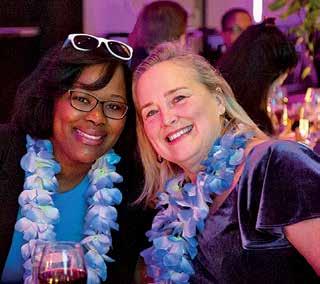
More than 350 alumni, faculty, staff, elected officials and friends of Horizons at New Canaan Country School showed their enthusiastic support for the program by attending the nonprofit’s biennial benefit Feb. 2 at the Hyatt Regency Greenwich. The evening’s theme, “Make a Splash!” highlighted the ripple effect the Horizons program has on its students and their families, while also acknowledging and honoring the numerous local homeowners who have graciously donated their pools for recreational swim lessons, a hallmark of the Summer Program.
Proceeds from the evening will support the Horizons mission to build brighter futures for under-resourced children from Norwalk and Stamford.
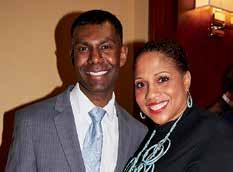

Excerpted from remarks made by Executive Director Nancy von Euler at the Horizons Benefit







For more than five decades, Horizons has been building brighter futures for under-resourced children, primarily from Norwalk and Stamford, by providing a broad array of academic and enrichment programs that now support more than 400 students a year from Kindergarten through 12th grade. Our students are beating the odds: Last year, 100% of our high school seniors graduated, and every single one of them was accepted to college. I feel so privileged and proud to be part of this transformative organization.
I am also thrilled to have the honor tonight of recognizing and celebrating the incredible contribution of our swimming pool donors. Thanks to the generosity of these donors, our children are able to swim daily during the summer and get access to a powerful outdoor classroom where they build grit, resilience, determination and confidence. Think about it — how better to learn to face down fear, fail and recover, set a goal and strive towards it, than to learn to swim. Again and again, we see that the skills and confidence our students develop in the pool translate into success in the classroom and in life.
The Dalai Lama said, “Just as ripples spread out when a single pebble is dropped into water, the actions of individuals can have far-reaching effects.” Pool donors, through your simple act of kindness and generosity, each of you has cast transformative ripples in the lives of our students that reach farther than we may ever know.
Head of School Aaron Cooper enjoyed meeting Country School alumni and parents of alumni at a reception on campus in October and at a young alumni gathering in New York City in November.
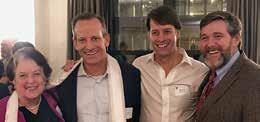




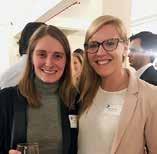


1. Sarah O’Herron Casey ’80, Jill Stevens
2. Carl Rohde ’66, Alice Burnham, Lyn Bremer Chivvis ’60, Tucker Golden ’90

3. James Delli Carpini, Kate Lynch Delli Carpini ’01, Steve Bloom ’03

4. Stephanie Bowling Zeigler ’81, Gigi Brush Priebe ’74, Alice Burnham
5. Jane Budnick ’05 and her mother, Anita Cobb.


6. John Weiss ’97, David Mandler ’01, Lee Cochran ’02, Dick Colligan ’01
7. Alex Gould ’07, Taylor Gould ’06
8. Melanie Silverman ’08, Mackenzie Swirbul ’08
9. Phoebe Knowles ’89, Suzy Gibbons Owen ’94, Melissa Miller Faucher ’91, Elena Kavanagh Phillips ’91
10. Head of School Aaron Cooper, Tucker Golden ’90, Eugene Bang ’92
11. Kristin Bergfeld ’59, Joel Post ’81, Derrick Queen ’81, Tom Speers ’73
12. Tom Speers ’73, James Knowles, Chief Financial Officer Bob Mueller, Joel Post ’81
13. Caitlin Maguire ’04, Ryann Tookes ’04



Head of School Aaron Cooper officially kicked off the 2018–2019 school year Sept. 6 at an all-school assembly that included the dedication of the Susan Haigh Carver ’51 Dining Hall & Commons.
In 2013, the Carvers first approached the school about making a gift that would be the largest to date in the school’s history, and one that would significantly impact the lives of Country School students and celebrate the sense of community that was so meaningful to Sue’s experience as a child attending the school. Throughout her life, she cherished the memories of her days at NCCS. Sue grew up in Darien, and after attending NCCS went on to Ethel Walker School and Smith College before she and her husband settled in the San Francisco Bay area. As an alumna, she returned in 2001 to celebrate her 50th reunion.
John Carver, husband of the late alumna in whose honor the building was dedicated, and their three children, Thomas, Amy and Jonathan, joined in the ribbon-cutting ceremony. Classmates of Sue’s from the Class of 1951 Hayden Connor, Gail Miller Stoddart and Linda Rook Stikeleather, along with her husband Allan; Judith Steinberg, a former NCCS parent and close family friend, and close friend Bill Jones, along with other friends, attended the ceremony and a private tree dedication in Mrs. Carver’s name.

One of our favorite events, a panel of recent graduates and parents of recent graduates returned to campus Jan. 10 to answer questions and share with current parents their perspective of the transition through and beyond Country School.

A big thank you to event moderator and President of the Alumni Council Tucker Golden
and panelists Finley Bean
(Brien McMahon
recent graduate Audrey
Mark
The Alumni Office continued its tradition of hosting a Thanksgiving reunion for our youngest alumni. This year, we welcomed back to campus Classes of 2016, 2017 and 2018.






1. The Class of 2016
2. The Class of 2017
3. Members of the Class of 2018 Nina Stoops, Georgia Rivero, Emma Herdeg, Audrey Magnusen, Lauren Walsh, Catherine Dewey
4. Meghan Sisk ’18 and Amalia Calderini ’18
5. Members of the Class of 2017 Bobby Gibbons, Kevin Barnard, Austin Andersen, Desmond Pratt
6. Members of the Class of 2017 Teddy Zinn, Dylan Koo, Bo Zeigler, Shane Baldwin


7. Members of the Class of 2017 Taylor Mitchell, Emily Riccardi, Merrill Bright, Haley Strom
8. The Class of 2018
Save the Date!
November 25, 2019
Thanksgiving Reunion for the Classes of 2017, 2018, 2019
1941
Kimmy Winship Shapleigh writes, “Very thankfully alive and well at 91+! I am now living in a villa at a retirement center in St. Louis. My husband, John Shapleigh, was a beloved St. Louis doctor who died in 2011. My daughters Melissa Thayer Hummer and Holly Thayer Eggert, both live in St. Louis, which is joyful for me. My daughter Alicia Thayer died in 1975, and my daughter Catsy Thayer, who taught at Rippowam Cisqua for many years, died in 2014. I am busy playing Mahjong and attending the symphony and repertory theater and seeing friends. I have many happy memories of Community School and Country School — would love to hear from classmates! 1143 Jo Carr Drive, Chesterfield, MO 63017.”
1943
Katharine Wadsworth Wilson writes, “Still working as LMFT; over 700 client appointments this year. Toured Cleveland and Amish country in Ohio with sister Cornelia. Brief trip to Italian Riviera and Monte Carlo. Published a book of verses, Happy Talk. Keeping up fitness and church activities.”
If not, please send your preferred email address to Director of Alumni Affairs Holly Donaldson Casella ’04 at hcasella@countryschool.net.
1945
NCCS Alumni Faculty and Staff members for the 2018–19 school year. Back Row: Josh Ziac ’86, Barbara van der Kieft Latimer ’85, Jeannie Staunton Bean ’83, Marshall Johnson ’04, Maria Sette ’92

Front Row: Catherine Mendoza ’98, Kent Findlay ’80, Madeleine Ker ’10, Daley O’Herron ’05, Hadley Merrill ’10, Abigail Manny Newport ’89,
Sally Hughes Carr, of Madison, CT, passed away on Nov. 27, 2018. Please see In Memoriam
Edward Keane, of New York City, died on July 24, 2018. Please see In Memoriam
1947
Frances Fisher Wilson, of Ormond Beach, FL, passed away on March 26, 2018. Please see In Memoriam
1949
Linda Walleen Will, of Alexandria, VA, passed away on Jan. 31, 2018. Please see In Memoriam
1950
Nancy Jones Tennstedt, of Hilton Head Island, SC, passed away on Aug. 30, 2018. Please see In Memoriam.
1951
Diane Monson, of Stamford, CT, passed away on Sept. 18, 2018. Please see In Memoriam
1952
Alexander Neave, of New York City and Litchfield, CT, passed away on Sept. 24, 2018. Please see In Memoriam
1 Jennifer Robbins Manocherian ’53 and Joan Dominick O’Brien ’53 at the Place de la Concorde in
1 Jennifer Robbins Manocherian writes, “Joan Dominick O’Brien, my daughter Kim and I went to Berlin and Paris in October — here’s Joan and me at Place de la Concorde dressed for a dinner for the opening of an exhibition outside the Musee du Jeu de Paume. Friends for over 70 years — not bad!”
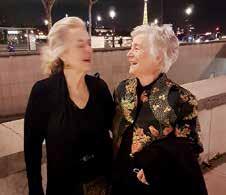
Bob Shields writes, “I’ve made it to age 80 — with no pain and no known medical problems. I try to exercise every day. I have two wonderful daughters — Jenny and her family live in Lake Lucerne, Switzerland, and Ginger lives in St. John, USVI. Jenny now has two children, Sadie, age 3, and Fred, 3 months old. So I am finally a grandfather!”
Joan Abernethy Wright writes, “Sorry I couldn’t make the 65th reunion; maybe the 70th. Still making art of one sort or another and involved in small town politics! Never a dull moment.”
2 Leslie Powell Siggs writes, “Wonderful 12-day trip to South Africa (Cape Town and safari in Kruger National Park) in October! If any of you are Facebook users, you can see a few of the hundreds of pictures we took. Also, had my third hole-in-one in January in Tucson, where we live in the winter! That’s our house in the background.
Peter Uhry writes, “Going to New Canaan Country School established a sense of curiosity, awareness and wonder about the world in me. These were key takeaways from the years I felt fortunate to attend NCCS. My wife and I remain avid travelers and often wonder if places improve with age.
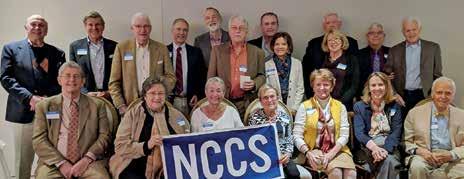


Spend any time in Europe and the answer is yes and no. There is so much history and, while not everything has survived or been properly cared for, what you see and experience usually provides a window to the past and raises questions about the future. In Vienna and Prague, the old architecture and long-established museums showcase history quite well. We visited both cities as well as Dresden and Berlin this last fall using ultra-modern trains to move between one area and the next. The WWII destruction in both Berlin and Dresden convey quite a different feeling than Prague and Vienna since so much is newer architecturally. Berlin and Dresden show history through a different lens. And this leads me to another thought. After all these years, having ridden the school bus from Pound Ridge with my
Did you know there are creative ways to support Country School? Giving techniques called planned gifts allow you to create win-win solutions for you and Country School. To join The Welles Society or to ask a question about estate planning, please contact Associate Director of Advancement Diane Briggs at dbriggs@countryschool. net or (203) 801-5619.
sister Katy Uhry Darr ’50 and brother Tom Uhry ’51, I find it amazing that I can still trace nearly the entire bus route in my head to this day. It was 45 minutes each way and highlighted by passing the Philip Johnson Glass House on Ponus Ridge where we all hoped to catch someone running around without any clothes. My wife and I visited the Glass House in 2017 and it is certainly more interesting to look at than it was in the 1950s. That is my take anyway. I am not sure why … as there aren’t any naked people running around the property now. Hope everyone is healthy and well.”
3 The Class of 1956 gathered for a minireunion in October 2018 at the Roger Sherman Inn in New Canaan.
4 The Class of 1958 gathered on campus in October 2018 for a tree dedication in recognition of their Annual Fund support for their 60th Reunion in May 2018.
Hardy Jones, of St. Augustine, FL, passed away on Dec. 12, 2018. Please see page 63 and In Memoriam.
Bill Shields is now spending summers in New Canaan and fall, winter and spring in Fort Myers, FL.

The Class of 1959 will gather for its 60th Reunion at NCCS this May. For more information, please visit countryschool.net/reunion.
Dave Gens writes, “My son Ryan (36) got married July of 2018. Happily, my wife of 41 years, who was rendered quadriplegic after a fall in 2017, was able to attend. That was a blessing. In December of 2018, I was honored with an endowed scholarship:
The David R Gens, M.D. Shock Trauma Scholarship Endowment for the University of Maryland School of Medicine. My brother John Paul Gens ’60 came down from New Hampshire for the ceremony. I am also the 2019 winner of the Leonard Tow Humanism in Medicine Award at the University of Maryland School of Medicine. These awards were given for teaching medical students over 40 years and being active clinically at the Trauma Center for the same amount of time. Thank you NCCS for exposing me to fantastic teachers as role models.”
Andrew “Sandy” Ingraham, passed away April 5, 2017, in Beaufort, SC. Please see In Memoriam
We welcome your suggestions for future Alumni Award candidates. Please send nominations to Director of Alumni Affairs
Holly Donaldson Casella ’04 at hcasella@countryschool.net. Please include name, class year and a short explanation of the candidate’s accomplishments. To find out about previous New Canaan Country School Alumni Award recipients, visit www.countryschool.net/alumni.
In the crystalline blue waters north of Grand Bahama Island, filmmaker Hardy Jones discovered an elusive treasure — a school of wild dolphins that welcomed humans into their undersea world. That 1978 encounter changed Hardy’s life, and his films and advocacy helped inspire a global campaign to save dolphins and whales from brutal slaughter and ocean contamination.
Hardy had been fascinated by dolphins as a child and started scuba diving at age 15. He was a television journalist researching the consciousness movement in the late 1970s when he set out to learn more about dolphin intelligence.

“I thought ‘I’ll just go out and make a movie.’ I was more than naïve. Even Jacques Cousteau told me it couldn’t be done.”
Hardy’s immediate, momentous connection with the pod of equally curious spotted dolphins was captured in his first award-winning documentary, “Dolphin.” “I was enthralled.” He would return to film these dolphins over the next three decades, including his 2005 PBS film “The Dolphin Defender.”
Shortly after his initial bond with the sleek, smart marine mammals, Hardy learned that Japanese fishermen were killing dolphins by the thousands. “My personal contact with dolphins created a sense of obligation in me to do something about that.”
Hardy exposed that atrocity and others, and has won numerous filmmaking and conservation awards for his 20-plus documentaries and his series for PBS, Discovery and National
Geographic. In 2000, Hardy and actor Ted Danson founded Blue Voice, an ocean conservation organization dedicated to protecting dolphins and whales from slaughter and exposing the harmful level of toxins in the marine environment.
For Blue Voice executive director Hardy, the chemical pollution crisis became personal when he was diagnosed in 2003 with multiple myeloma, a form of blood cancer. His test results showed highly elevated levels of toxins also found in evergreater concentrations in dolphin populations. He underwent treatment while living in St. Augustine, FL with his wife Deborah.
Hardy received the Country School Alumni Award in 2008, saying at that time, “I consider my time at New Canaan Country School one of the most wonderful gifts imaginable. It enabled me to go forward in my life with a sense of competence and confidence.”
After NCCS, Hardy graduated from Choate (’61) and Tulane (’66). He served in the Peace Corps for two years, then worked for United Press International and CBS News before becoming a filmmaker.
In his book The Voice of the Dolphins, Hardy recounted his decision to film “The Dolphin Defender” about his life’s work. He was in remission at the time, so “I decided to the throw it all in. I thought, ‘Fortune favors the bold.’ ”
Sadly, Hardy passed away on December 12. His documentary film will be released in 2019. Please see In Memoriam for more.
5 Andy Wilcox welcomed his first grandson, Shipley Blizard Wilcox, on Dec. 24, 2018.

The Class of 1969 will gather for its 50th Reunion at NCCS this May. For more information, please visit countryschool.net/reunion or reach out to Reunion Chairs: Bill Putnam, bputnam327@gmail.com; Dianne Crary, dcrary125@gmail.com
Dianne Crary writes, “Looking forward to our 50th reunion and hoping that everyone will try to make it back! I am splitting my time between New York City and Fishers Island, which is the perfect balance between city and country life. If anyone comes to NYC, please give me a call.”
Alison Taggart-Barone retired from being a Photo Editor for the Golden Gate National Parks Conservancy, and is now concentrating on her personal artwork and volunteering for the National Parks.
Johnny Reid and Paula Kennedy Harrigan ’81 (parent of Annie ’22) have teamed up to form Pass the Pick Productions, LLC (www.passthepick.com) and have been filming a premium HD music
series that features documentary and liveaction music performance programs. Some of the filming took place in Clarksdale, MS, at actor Morgan Freeman’s blues club, and in Nashville, TN, in a whiskey distillery. Freeman also provides his classic voice on some of their content. Pass the Pick signed six artists and is currently releasing the music worldwide through The Orchard, Sony Music’s independent distribution arm. The Pass the Pick roster includes two-time Grammy nominee Cedric Burnside, Grammy nominee Shannon McNally, Willie Nelson’s son Lukas Nelson, and Dexter Allen, among others.
Brin Luther writes, “Hello Class of 1976. It’s hard to fathom that our 50th Anniversary is in 2026. As I creep closer to age 60, I find myself the joyful owner of a 10-year-old show hunter mare, Nolen Lane, aka Zoey, and a 5-year-old Off the Track Thoroughbred foxhunter gelding, Champion’s Dinner or Champ. What a life with two horses in two locations. I hope some of my NCCS riding classmates have a horse too. Look me up if you want to ride one of mine near Middleburg, VA, or just come visit!”
1980
6 Katie Hutchison writes, “In the spirit of shameless self-promotion: My latest book The New Cottage from The Taunton Press was released in December 2018. It follows on the heels of my first book, The New Small


We are restocking our bookshelves. If you have published a book, please send a copy to Director of Alumni Affairs Holly Donaldson Casella ’04.
for the latest alumni news and updates in real time! Share wedding photos, chance encounters, minireunions and, of course, your favorite throwbacks for #TBT. To submit photos, direct message through Instagram or email to Director of Alumni Affairs Holly Donaldson Casella ’04 at hcasella@ countryschool.net. Please identify everyone in the photo, with class years wherever possible — and feel free to include a caption!
House from The Taunton Press, which was published in the fall of 2015. Find them both on Amazon or at a local independent bookstore near you. All the best to the class of ’80! Cheers!”
1982
8 Greg Spotts is Assistant Director and Chief Sustainability Officer of the LA Bureau of Street Services. Greg oversees 500 staff and is currently hiring 55 new tree care specialists to improve the Urban Forest.

1984
Tom Piper’s film “Five Seasons: The Gardens of Piet Oudolf” won the Polly Krakora Award for Artistry in Film at the Environmental Film Festival in Washington, DC, in March 2018.
1989
The Class of 1989 will gather for its 30th Reunion at NCCS this May. For more information, please visit countryschool.net/reunion or reach out to Reunion Chairs: Catherine Broadhead, catherine.broadhead@gmail.com; Heather Weed Goldberg, hgoldberg2003@ yahoo.com; Phoebe Knowles, phoebe. knowles@gmail.com; Abigail Manny Newport, anewport@countryschool.net
1992
Adrian Ulrich married Marina Rutherfurd on Nov. 10, 2018, at the Lyford Cay Club in the Bahamas.
1994
The Class of 1994 will gather for its 25th Reunion at NCCS this May. For more information, please visit countryschool.net/reunion or reach out to Reunion Chairs: Suzy Gibbons Owen, sgibbons@dkpartners.com; Davina Brislin Lilley, Davina.lilley@gmail.com

Alexandra Demou Esparza writes, “living in Mexico with husband, Emmanuel Esparza (Alex Hammond’s cousin). Our Lola is 6, Alejandro 2. I have a relocation business, a real estate business, I import Greek olive oil, and consult on boarding schools abroad. Busy!”
Lauren Oakes and her husband, Matt Craven, welcomed Calder Henry Mather Craven on Aug. 25, 2018. Calder was born five weeks early, but mom and baby are doing well! Lauren also just published her first book: In Search of the Canary Tree, which chronicles how plants and people cope with their rapidly changing world — and the resiliency of forgotten forests, flourishing again in the wake of destruction, and a diverse community of people who persevered to create new relationships with the emerging environment. See also Faculty News page 58.
Allie Beck writes, “I’m still living in Salt Lake City and am still with the same engineering firm I joined nearly six years ago (though we recently merged with another firm, Jacobs). I am an environmental engineer, focusing on air quality and environmental compliance primarily for the USAF but also some private clients around the world. Last year, I got my P.E. license so am thrilled to have that behind me (and enjoy all the powder days I missed while studying last year). Andrea Griffin and I have been in touch and missed each other in
Did you know that Corporate Gifts are a great way to increase your personal gift to Country School? Please check with your employer’s human resources department to see if it participates in a matching gift program, or check our online matching gift database: countryschool.net/support/ways-to-give. Obtain a form from your company, send it to us with your gift, and we’ll take care of the rest. For more information, contact Diane Briggs in the Advancement Office at (203) 801-5619 or dbriggs@countryschool.net.
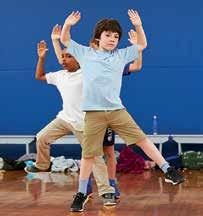
Let the Alumni Office know so we can send you a NCCS banner for photography! Reach out to Holly Donaldson Casella at hcasella@countryschool.net or (203) 801-5687.

London in December while I was there on a business trip and she was just moving there and settling into a new job. Soon! If anyone is ever out in the Park City or Salt Lake area (or skiing Alta), let me know as it would be fun to do some runs or grab a drink!”
Matt Heineman directed a new film, “A Private War,” which hit theaters nationwide to much acclaim in November 2018. For more, please see page 53.
The Class of 1999 will gather for its 20th Reunion at NCCS this May. For more information please visit countryschool.net/reunion.
Mary Birnbaum will direct La Bohème to open the 2019 season of Santa Fe Opera in July. For more on Mary, please see page 54.
9 Arielle Traub writes, “my husband Ethan and I welcomed our daughter, Zoe May Traub Prosnit, on Sept. 19, 2018. We are thrilled, and so is big brother Caleb!”

10 Annie Rauscher married Larry Kennedy on Sept. 8, 2018, on Nantucket. NCCS alumni in attendance included members of the Class of 2002, Thomas Reed ’01, Brooke Cavanaugh Reed ’01, Annie Greenwood, BZ Reed and Fifth Grade Teacher and friend of the bride, Andrew Bevan.

11 Emmy Burleigh married Doug Grunseich on Sept. 29, 2018, in Woods Hole, MA. Many NCCS alums were in attendance, including siblings Sarah Burleigh ’02, Connor Burleigh, Cornelia Burleigh ’06, and Tucker Burleigh ’08 and cousins Phoebe Casey ’15 and Elizabeth Casey ’15 and her aunt, Sarah O’Herron Casey ’80, P’13,’15,’15
Mike Karp and his wife recently moved to Stamford, and Mike stays busy running a boys’ sleepaway camp in Maine called Camp Manitou.

Matthew Heineman ’98 has directed a new film, “A Private War,” which hit theaters nationwide to much acclaim in November 2018. A biopic of Marie Colvin, the legendary, eye-patch-wearing Sunday Times correspondent, the film received positive reviews since it first premiered at the Toronto Film Festival.

“The director and screenwriter remind the audience not just of the humanism that drives so many reporters, but also the extreme danger they put themselves in to bring us the truth,” The Washington Post stated in its review.
“He has made a deeply distressing, authentically moving psychological study of unswerving obsession,” said The New York Times
In the spring of 2015, Heineman, who is well-known for the hard-hitting documentaries “Cartel Land” and “City of Ghosts,” was inspired to make this film by the people who often dedicate their very lives to the craft of journalism.
“I had previously made ‘Cartel Land’ — and I was sent a number of different scripts; none spoke to me, but I got an early draft of this one and it spoke to me in a profound way — it was a film I had to make,” he explained. “I’ve been in conflict zones before, in torture chambers — I’ve been shot at, so her story is not foreign to me — and neither is coming back to New York City and having those experiences linger with you. I deeply empathize with Marie Colvin. What I’ve tried to do is similar to what she tried to do — take complex geopolitical conflicts and humanize them. I felt a kinship to her and felt like it was a story I had to tell.”
“In this era of fake news and sound bites, for me the film is not just an
homage to Marie and to journalists like her fighting for the truth — but an homage to journalism and the importance of journalism,” said Heineman by phone.
The role of Marie Colvin is played in the film by Academy Award® nominee Rosamund Pike. Additional cast members include Jamie Dornan and Academy Award® nominee Stanley Tucci. Heineman, who is himself an Academy Award® nominated director for “Cartel Land,” has been called by The Sundance Film Festival “one of the most talented and exciting documentary filmmakers working today.”
At the 76th Golden Globe Awards, the film earned nominations for Best Actress in a Motion Picture — Drama (Pike) and Best Original Song (“Requiem for A Private War”), while the director (Heineman) received a nomination for
Outstanding Directorial Achievement of a First Time Feature Film Director from the Directors Guild of America.
Heineman, the recipient of the school’s 2012 Alumni Award, recalls his time as a student at NCCS as having influenced his expanding worldview.
“I look back very fondly on my time at Country School — one of the many things NCCS did for me is make me curious about the world, which has resonated in all the work that I’ve done. NCCS made me inquisitive, curious and want to explore. Now I have the privilege of diving into new worlds and exploring them every few years. I feel a huge responsibility to explore these issues and tell these stories.”
For more information about the film, please visit www.aprivatewarfilm.com
“One of the many things NCCS did for me is make me curious about the world, which has resonated in all the work that I’ve done. ”

There is no shortage of artistic talent in the Birnbaum family. As someone who spent quite some time at their house growing up, I can attest that music and performance have always been at the center of life for the Birnbaums, both in formal and informal settings. As girls, Mary ’99 and Flora ’04 sang in the Metropolitan Opera Children’s Chorus, and our playdates often consisted of elaborate performances, usually with full costume and set design!
As you might expect, Mary and Flora also performed at Country School — in musicals, select chorus and a wide range of other venues throughout their collective 15 years here. Mary remembers: “Rhythms class with Francine Piggott in Lower School, concerts with Marsha Whitman in Middle and Upper School and winter musicals with Mr. Garrison in Upper School, as well as the time that Mr. Berwick and Mrs. Purcell let our ninth grade class make DNA: The Musical rather than taking a final exam.” She adds, “For us, it was the dedication of the teachers at NCCS who fostered a creative learning experience that furthered our love of the arts.” And Flora adds, “The Christmas pageant in the Lower School, the sense of community, and the way each Country Schooler was encouraged to march to the beat of their own drum helped us find who we were as people and how best to express ourselves!”
Their artistic prowess continues today as both women find success in the performing arts world. Mary is the Associate Director of Opera Studies at The Juilliard School, where she teaches acting to opera singers. She is a freelance stage director of theater and opera regionally and internationally. Mary was nominated for “Best Newcomer of 2015” at the International Opera Awards in London and, this year alone, is set to direct three major shows: Dido and Aeneas at Juilliard this winter, Empty the House at the Curtis Opera Theater in Philadelphia this spring, and La Bohème at the Santa Fe Opera this summer. Mary brings an avant-garde style to her directing and is committed to helping young artists develop through her work at Juilliard and the Orchard Project Greenhouse, an arts accelerator that Mary helped found.
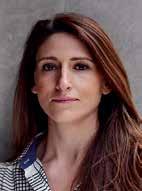
Flora has been involved in some of the buzziest projects of 2019 so far. After starting out at a talent agency and transitioning to writing and directing her own independent work, she recently landed an exciting opportunity on the writing team for the new Netflix series Russian Doll, which premiered on Feb. 1; Amy Poehler and Leslye Headland are the executive producers, and it stars Natasha Lyonne. Flora is also writing for the third season of the Showtime series SMILF, and is working on a feature film, which she will direct.

You may wonder, will Mary and Flora find an opportunity to collaborate in the coming years? Turns out there’s already a musical in the works — about sisters, of course! Keep your eyes on these two, and check out their impressive work while you’re at it.
12 Lindsay Luke married Scott Gates on Oct. 6, 2018, in Richmond, VA. NCCS alumni in attendance included Lindsay’s siblings, Betsy Luke ’07, Johnny Luke ’08; bridesmaids Haley Priebe and Holly Donaldson Casella ’04, Chelsea Priebe ’06, Hunter Priebe ’08, and Gigi Brush Priebe ’74, P’03, ’06, ’08.
The Class of 2004 will gather for its 15th Reunion at NCCS this May. For more information, please visit countryschool.net/reunion or reach out to Reunion Chairs: Holly Donaldson Casella hcasella@countryschool.net; Caitlin Maguire cqmaguire@gmail.com; Marshall Johnson mjohnson@countryschool.net
Flora Birnbaum married Sam Sackeroff on Aug. 4, 2018. Please read more, at left.
13 Nikki Bongaerts married Peter Magrath on Sept. 20, 2018 in Alta, UT. Many NCCS alumni were in attendance, including her mom Alex Bongaerts-Duval ’72, P ’02, ’04, Matron of Honor, Holly Donaldson Casella,

Please submit your news and updates to Director of Alumni Affairs Holly Donaldson Casella ’04 at hcasella@countryschool.net or on our website. You can also submit notes via mail using the enclosed return envelope. Share your own news, or tip us off to milestones, news and achievements of classmates, your children or others in our community!
Maid of Honor, Kim Thompson, bridesmaid Eliza Kontulis Getz, as well as Heather Wegner Wald, Kelsey Craig and Chip Stinchfield ’69.
14 Holly Donaldson Casella and her husband, Adam, welcomed Clarke Thatcher Casella on December 21, 2018.

15 Drew Fink married Daniela Uribe on Nov. 10, 2018, in Bogota, Colombia. NCCS alumni in attendance included Carly Fink ’07, Channing Tookes and Edin Fako.



In December 2018, Upper School English and History Teacher Marshall Johnson ’04 completed a two-year master’s program at The Klingenstein Center for Independent School Leadership, Teachers College, Columbia University. Also, congratulations to Marshall on his engagement to Meghan Cratty! A summer 2020 wedding is expected. See also Faculty News page 58.
Xandy Peters continues to create as a knitting designer and teach her technique throughout the country. Her stacked stitch technique has just been launched by Bluprint (formerly Craftsy), an online learning platform, with a class “Stacked Stitches: Knitting in Wild Color.” She continues to have her work published, most recently with Pom Pom Quarterly Issue 27 Winter 2018, based in London.
2018.
To be included in the upcoming Alumni Art show, please contact Director of Alumni Affairs
Holly Donaldson Casella ’04 at hcasella@countryschool.net.
Alumni, do you have expertise to share with students? Contact Holly Donaldson Casella ’04 with your idea! hcasella@countryschool.net
17 Heather Wegner Wald and her husband, Steven, welcomed Sienna Jane Wald on Feb. 27, 2019.

18 Julia Maguire married Lucas Henderson on Oct. 20, 2018, in CT. NCCS alumni in attendance include Julia’s siblings, Caitlin Maguire ’04, Charlotte Maguire ’10, James Maguire ’12 and David Maguire ’09 — as well as Flora Birnbaum ’04, Ryan Tookes ’04, Caroline Nisenson, Nick Rohn ’12, Channing Tookes ’04, Alice Huck ’04, Allison Roberto ’09, Taylor Bolton, Averill Roberto, Amy Cohen and Argo Caminis ’93.



19 Charlie Merrill married Elizabeth Morris on Sept. 28, 2018, at the Ausable Club in NY. Charlie’s siblings Olly Merrill ’03, Carrie Merrill ’08, and Emma Merrill ’10 were in attendance.
20 Lauren Karp married Andrew Bonnesen on Sept. 2, 2018, in Newport, RI.
21 Paige Gonye married Ryan Thacher on Feb. 9, 2019, in Vero Beach, FL.

22 Jasmine Nelson married Emmanuel Jackson on April 22, 2018, in Houston, TX. In attendance were NCCS and Horizons alumni including bridesmaids Danielle Nelson


(Horizons) and Rishonda Thomas ’02, Charlotte Buchanan, Jeffrey Joseph, Taylor Joyner and Alijah Joyner (Horizons).
The Class of 2009 will gather for its 10th Reunion at NCCS this May. For more information, please visit countryschool.net/reunion or reach out to Reunion Chairs: Camilla Arntzen, carntzen912@gmail.com; Peter Maturo, maturop@gmail.com
23 Jon Karp writes, “I recently got back from Lusaka, Zambia, in November. I was there for six months working as the head of analytics for a vertically integrated commercial tilapia farm named Yalelo. I am now back in New York working as a consultant in the medical devices space.” While in Africa, Jon also ran the Victoria Falls Half Marathon in Zimbabwe.
Christopher King writes, “I’m in my first year of a PhD program in Molecular Biophysics and Biochemistry at Yale University, and still drawing on excitement from eighth grade chemistry and ninth grade biology at Country School!” 2016

Portia Cummings is one of four students taking part in the new Advanced Math & Science Research (AMSR) Program at the King School this year. The AMSR course focuses on math and science research techniques, providing methods to help students further understand how research
is conducted. In conjunction with the class, students attend an internship at an R01-level research laboratory to get handson experience in the field of modern scientific research. Portia is currently working in the Blasberg Laboratory at Memorial Sloan Kettering Cancer Center in New York, NY. The laboratory is led by neurologist Dr. Ron Blasberg and mainly focuses on different types of imaging to detect cancer and to have a better understanding of how tumors metabolize. Portia’s project last summer involved investigating LDH inhibition and how it affects the growth of cancer cells; this year, she is working to identify a reporter gene with specific features that will allow for easier imaging of cancer cells.
24 Athletes from the Class of 2018 and 2019, Bennett Griskey ’19, Peter Miller ’19, Thomas Ricciardelli ’19, Jeffrey Ricciardelli, Charlie von Stade and Lucy Jones met up on game day at Westminster in Fall 2018.

In December 2018, Upper School English and History Teacher Marshall Johnson ’04 completed a two-year master’s program at The Klingenstein Center for Independent School Leadership, Teachers College, Columbia University. See also Class Notes page 55.
On May 16, First Grade Apprentice Teacher Melissa Fryer completed a dual Master’s degree in Early Childhood Education and Early Childhood Special Education at Manhattanville College.
Language Arts Department
Co-chair and Upper School Learning Resources Teacher Lauren Romeo received a Graduate Certificate in Special Education from Lesley University in Cambridge, MA.
Adam and Holly Donaldson Casella ’04, Director of Alumni Affairs, welcomed a son, Clarke, who was born Dec. 21, 2018. See also Class Notes page 55.



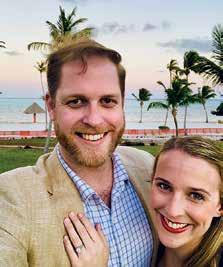

▸ Congratulations to Grade 6 Teacher Brayden Henry and former Apprentice Annie Upton on their engagement! An August 2020 wedding is planned.
▲ Director of Innovation and Academic Technology Aron Back won the 2018 TriState Bouldering Series 3 in the master category, competing in five climbing competitions and winning the final round (three first place and two second place finishes), and was the overall winner of his category.

▲ Congratulations to Early Childhood Assistant Teacher Daley O’Herron ’05 and Kyle Avery on their engagement! The couple met at St. Lawrence University in September 2008. They are planning a summer 2020 wedding.


Faculty professional development opportunities, including graduate coursework, are made possible by financial resources from the Special Professional Development Fund and the Ninth Grade Endowment Fund.
▲ In January, Advancement Support Manager Renee Bornstein (front row, second from left) and her family spent a weekend in New Orleans, celebrating her milestone birthday and the engagement of her daughter, Joanna, to Nathan Allen.
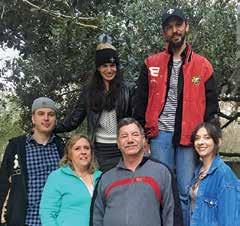
▲ Mary Kate and Sean Robb, Lower School World Language Teacher, welcomed a daughter, Skye, who was born Jan. 18. Siblings Luna, Samson and Clara are thrilled.

▲ In December, Facilities Director Ed Kirk (second from right) was a panelist at the Professional Women in Construction (PWC) Conference. PWC provides a professional networking and educational venue for women in all aspects of design, construction, legal, insurance and financing in the construction field. Ed has participated as a panelist 10 of the last 15 years. Other schools represented on this year’s panel included Choate Rosemary Hall, Loomis Chaffee, Hackley School, Avon Old Farms and Phillips Academy at Exeter.
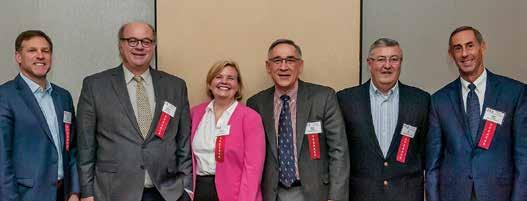
THE FOLLOWING ARE REMARKS BY RYAN BUCKLEY, HEAD OF UPPER SCHOOL AT TOWER SCHOOL, GIVEN NOV. 19, 2018, AT A MEMORIAL SERVICE HONORING TIM DELEHAUNTY, FORMER HEAD OF UPPER SCHOOL AT NEW CANAAN COUNTRY SCHOOL FROM 2008 TO 2017. PLEASE ALSO SEE IN MEMORIAM PAGE 64.

I’ve known Tim, Theresa, Ian and Shea for the past 13 years, first while working as a teacher at Lawrence Academy, then at New Canaan Country School for eight years as a teacher and administrator — and finally the last two years at Tower as Head of Upper School. Tim and I have worked, essentially, at three different and great schools together during this time. It has been an amazing journey and a blessing. During this time, I got to know Tim as a colleague, teacher, coach, Dean of Studies, Head of Upper School, Head of School … mentor, good friend and wonderful family man.
Although my favorite running joke with Tim was turning to him and saying, “Tim, you really need to stop following me around,” everyone knows that I was the one following him all these years. I want to share a couple of stories and memories that get at why. I also want to finish with a few thoughts about Tim as Head of School at Tower.
When I was at Lawrence Academy beginning my first year of teaching, Tim was Dean of Studies. It was the first day of school. I can remember approaching my door in the Ansin building as 15 ninth grade students were waiting inside. Needless to say, I was a bit nervous. As I reached for the handle, I heard a voice say, “Are you ready?” It was Tim and he was there waiting for me. I responded with as much confidence as I could but probably showed some mild signs of trepidation. “Yeah, I think so,”
I responded. Sensing my nerves, he then proceeded to shake my hand and said: “Don’t worry, your only job this year is to survive.” And then he smiled with that unmistakable broad smile of his. The weight of the world rolled off my shoulders. At that moment, I realized he was one of the good ones (good at heart), someone who deeply cared about the welfare, well-being, and success of others. He would be someone who would always be there when needed. He magically seemed to know what that might be at any given time: a sense of balance, encouragement, or an appropriate challenge. He cared more about the well-being and growth of his colleagues than he cared about his own success. I felt it on that first day in 2005 and every day since. You follow the good ones, and so I did. In New Canaan, I got to know Tim as a leader and mentor.
I can remember one day rushing into his office in the Stevens Building searching for answers. I was a young administrator and was trying to find my way and find my voice. I knew he had the answers, so I popped into his office. Time was always limited, so I just asked him for the guidance and for the answers — to point me in the right direction … now. But he wasn’t having it. Once again, that smile came out. He grabbed a book from his bookshelf (Tao of Leadership) and tossed it at me and said, “Why don’t you read this for a while, you might find your own answers in there.”
You follow the good ones who care deeply about others and who are always there — and also the leaders who sacrifice themselves intentionally and spend the time to guide, elevate, and teach others in reflective and real ways. He demanded reflection back from colleagues, for he knew it would lead to their growth. Tim took great pleasure in this work, and I can’t tell you how many students, teachers and administrators he guided to become their best selves in whatever they were doing. So I kept following him.
It didn’t surprise me one bit how successful Tim was here at Tower leading the school. He accomplished so much in a short period of time. The list of advances and achievements is considerable and the school is on a great track moving forward thanks to him. Yet, it is how he accomplished these things that always amazed me. He listened. He was mindful. He brought people together to build consensus, believed in them, and drew on their talents to create solutions. We will pick up his flag of leadership and carry it as he did — full of spirit, thoughtfulness, humility, wisdom and kindness. That will carry on.
We come to think of Head of School as a CEO position, which it is these days. The organizational demands and business demands are greater than ever in schools. However, the term headmaster, which predates the Head of School title, actually means head teacher. Tim was the CEO and head teacher here at Tower. The students and kids always came first — highlighted by the Orange Chair, which sat in his office next to his desk. It symbolizes the individual student. It is a reminder to always ask the question: “What is best for the student?” That is a question he lived by and never forgot throughout his years, even as Head

of School. He had an unyielding love for teaching kids, for being present with kids, and for creating solutions and initiatives that would profoundly affect their experiences for the better. The students sensed his devotion to them and they loved him for it. They loved him because (in their words) he cared about them, was present with them, understood them and always believed in them. So, I leave you with this reflective question: Is there any better way to be than that?
To Theresa, Ian and Shea: We love you dearly. Our hearts are with you. You will always be family. We are going to work tirelessly at Tower to continue Tim’s legacy of thoughtful, kind and inclusive leadership. His spirit is alive in these halls and in all of us. That is a guarantee.
In closing, I would like to offer words Tim spoke when saying goodbye to New Canaan Country School for the last time before coming to Marblehead. During the farewell dinner in New Canaan in June of 2017, Tim was called up for a speech (an encore of sorts). In typical Tim fashion, he reluctantly made his way up to the microphone after minutes of cheers, applause and goading, and he offered these thoughts on endings and saying goodbye. He said to the crowd that night that he was fond of a saying his grandfather used whenever something was ending and it was time to say goodbye — whenever there was an unknown ahead and a new beginning.
Tim refused to say goodbye that night. Instead, he offered a simple declaration to the crowd:
“CARRY
Join us in celebrating and honoring members of the Country School community, past and present.
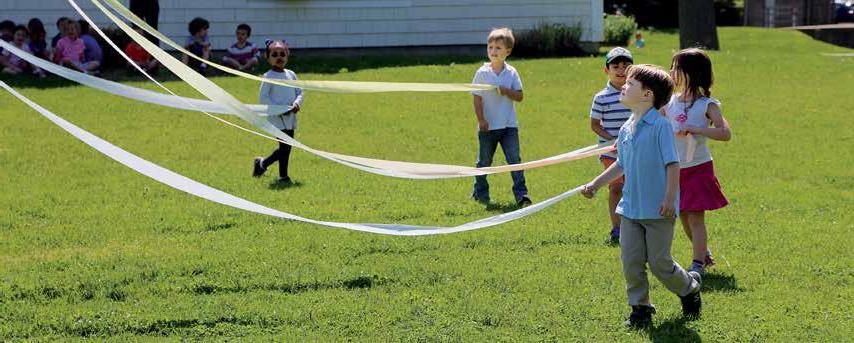
Adrian Ulrich ’92 to Marina Rutherfurd
November 10, 2018
Annie Rauscher ’02 to Larry Kennedy September 8, 2018
Emily Burleigh ’03 to Doug Grunseich
September 29, 2018
Lindsay Luke ’03 to Scott Gates October 6, 2018
Flora Birnbaum ’04 to Sam Sackeroff August 4, 2018
Calder Henry Mather Craven to Lauren Oakes ’96 and Matt Craven
August 25, 2018
Zoe May Traub Prosnit to Arielle Traub ’00 and Ethan Prosnit
September 19, 2018
Whitton Louis Merrill to Olly Merrill ’03 and Melissa Merrill
December 23, 2018
Nikki Bongaerts ’04 to Peter Magrath
September 20, 2018
Drew Fink ’04 to Daniela Uribe
November 10, 2018
Alexa Reid ’04 to Colin Smith
August 18, 2018
Julia Maguire ’05 to Lucas Henderson
October 20, 2018
Charlie Merrill ’05 to Elizabeth Morris
September 28, 2018
Lauren Karp ’06 to Andrew Bonnesen
September 2, 2018
Paige Gonye ’07 to Ryan Thacher
February 9, 2019
Jasmine Nelson ’08 to Emmanuel Jackson
April 22, 2018
SUBMIT A NOTICE on the website or contact Director of Alumni Affairs Holly Donaldson Casella ’04 directly at hcasella@countryschool.net or (203) 801-5687 with your news item.
Clarke Thatcher Casella to Holly Donaldson Casella ’04 and Adam Casella
December 21, 2018
Sienna Jane Wald to Heather Wegner Wald ’04 and Steven Wald
February 27, 2019
All milestones received after we go to print will be included in the next edition of the Bulletin, scheduled for fall 2019 and also posted on the website. Read more:
We offer the deepest condolences to the family and friends of the following members of our extended school community. To read more, please visit www.countryschool.net/milestones for full-length obituaries. You may also submit a notice on the website or contact Director of Alumni Affairs Holly Donaldson Casella ’04 directly at hcasella@countryschool.net or (203) 801-5687.
Sally Hughes Carr
Sarah (Sally) Hughes Carr, 88, of The Hearth in Madison, CT, passed away peacefully, Nov. 27, 2018, at The Guilford House.
Following Country School, in 1948 she graduated cum laude from Abbot Academy (now Phillips Academy Andover) in Andover, MA. She went on from there to Smith College in Northampton, MA, class of 1952.
She is preceded in death by her husband, Richard (Dick) S. Carr, Jr., her daughter Elizabeth Deming Carr and her grandson Wilem Johannes Yorke. She is much-loved “Mummy” to Richard S. Carr, III of Reno, NV; David B. Carr of Santa Barbara, CA; Margaret Carr Deák of Reseda, CA and Michael M. Carr of Madison, CT; and forever beloved “Granny” to her ten grandchildren and four great-grandchildren.
Hardy Jones passed away on Dec. 12, 2018, reportedly after a long battle from multiple illnesses. In 2003, he was diagnosed with multiple myeloma, a form of blood cancer often linked to exposure to toxic chemicals such as dioxins. His recent work was researching the relationship between persistent organic pollutants to cancer and other health problems in humans and marine mammals.


Following Country School, Hardy attended Choate Rosemary Hall (1961) and Tulane University (1966). In 2008, he received the NCCS Alumni Award and in 2016, was profiled in the publication 100 Faces of New Canaan Country School. To read the profile, please see page 49. He is survived by his sister, Betsy Jones Zwick ’63.
Diane Monson ’51
Diane Monson passed away on Sept. 18, 2018, in Stamford, CT. Following Country School, she attended Rosemary Hall and Radcliffe. She served on the NCCS Alumni Council from 2003 to 2017.
Alexander Neave ’52
Andrew
Andrew Clark Ingraham Jr. died of cancer after a long illness on April 5, 2017, in Beaufort, SC. He was 71.
Mr. Ingraham was born in New Canaan and following Country School, attended Phillips Exeter Academy, and St. Lawrence University. Following graduation in 1968, he served in the Army stateside for two years. With a 1973 law degree from George Washington University Law School in hand, he worked for two years for the Legal Aid Society in Brooklyn, then moved to East Hampton, NY, and started his own practice. He practiced law until 2003, retired to West Bath, ME, and then finally, Beaufort, SC, in 2015.
He is survived by daughter Erin Rogus of Nashville, TN; a son, Andrew Ingraham III of Brooklyn, NY, and his wife, Danielle Wagenhauser, of East Hampton, NY. His only sibling, a sister, Kitty Ingraham Arsenault ’60, died in 2011.
Keane ’45
Edward Webb
Keane ’45 died on July 24, 2018, in his long-time home on Gramercy Park in New York City at the age of 87.
Following Country school, Ted graduated from Phillips Exeter Academy (1948) and Harvard College (1952), served with the U.S. Army in Korea, and attended Harvard Law School (1957), where he was president of the Harvard Law Review editorial board. After clerking for Justice William Brennan at the Supreme Court (1957–1958), he went on to a career at Sullivan and Cromwell. He is predeceased by Mary, his wife of 60 years, and is survived by his children, Webb Keane, Jennie Dalton, and Metthea Baker, eight grandchildren, and two great-grandchildren.
Alexander Neave, of New York City and Litchfield, CT, died on Sept. 24, 2018, after a brief illness. He was the son of Alexander C. and Frances P. Neave, born August 28, 1937. He grew up in New Canaan, CT, and following Country School, graduated from Deerfield Academy (1955), Stanford University (1959) and University of Pennsylvania Law School (1962). His first marriage to the former Linda Shaw ended in divorce. He is survived by his wife of 40 years, Lynne Williams Neave, and three sons from his first marriage, Peter C. (Abigail), E. Parker (Patti) and Jonathan A. (Liz), and six grandchildren. He was predeceased by his brother Charlie ’47 in 2005. He spent 52 years practicing Trusts and Estates Law at Putney Twombly Hall and Hirson LLP, first as an associate, then as partner and finally as counsel.
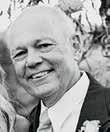
Nancy Jones Tennstedt ’50
Nancy J. Tennstedt, age 83, passed away peacefully in her sleep on Aug. 30, 2018, with her daughters at her side. Nancy’s life was challenged by a rare, untreatable neurodegenerative disease called Progressive Supranuclear Palsy (PSP).
Following Country School, she graduated from The Mary C. Wheeler School in Providence, RI, in 1953 and received her bachelor’s degree from the Childhood Education Foundation in NYC. She married Welles Murphey in 1955 and raised

their three daughters in New Canaan. Nancy married Eastern Airlines Captain Charles R. Tennstedt in 1982. They moved to Spruce Creek Fly-In Community in Port Orange, FL, where she engaged in numerous volunteer activities.
Nancy is survived by her sister Patsy McCree, her daughters Cindy Ackerman, Lin Crispinelli and Debbie Murphey McFarland ’81, her grandchildren Michael Crispinelli, Nicholas Crispinelli, Linsey McFarland, Matthew McFarland, Madison McFarland and her ex-husband and lifelong friend Welles Murphey, Jr. She was preceded in death by her husband of 28 years, Charlie Tennstedt, her sister Louise Beard and her granddaughter Stephanie Crispinelli.
Linda Walleen Weill ’49
Linda Walleen Will, Navy wife and mother of four, died Jan. 31, 2018, in Alexandria, VA.
Following Country School, Linda graduated from Skidmore College (’56), majoring in French and Music, and married Capt. John M. Will, Jr. Vivacious and ever the entertainer and Navy wife, she performed in amateur musicals and cabaret shows. She also supported and comforted the families of deployed submariners in the Wills’ many duty stations, including Hawaii and Rota, Spain. Linda is survived by her children, Eric of Mont Vernon, NH, Mark of Alexandria, VA, Lisa Kaess of Wilton, CT, and John Alex of Hampton, VA; their spouses; seven grandchildren and two great-grandchildren.
Frances Fisher Wilson ’47
Frances Fisher Wilson, 85, of Ormond Beach, died on March 26, 2018 at Halifax Health Hospice Ormond Beach Care Center.
A Florida resident since 1958, Frances grew up in New Canaan. Following Country School, she attended Oldfields School in Maryland, went to live in Paris for a season with her sister Alice, and traveled extensively in Mexico and Central America. Frances then earned a Bachelor of Fine Art at Rhode Island School of Design. In 1956 she married William Brookfield, Jr., and they moved to Ormond Beach, where they raised five children.

She is survived by her sister Alice Fisher Blood ’51, all of her children: Kate, Bill, Richard, Beth and Jonathan; her grandchildren: Stephen, Mark, Christopher, Nell, Cameron, Sarah, Clemency, Rose, David and Luke. She is predeceased by brothers Walter ’39 and Bill ’45.
Timothy Delehaunty
Timothy Delehaunty P’14, ’17, former Head of Upper School, passed away suddenly at home in Marblehead, MA, on November 14, his 50th birthday.

Tim grew up in central Massachusetts, first attending Worcester Academy and then College of the Holy Cross. Following a year in the Navy ROTC program — during which he experienced claustrophobia while on a ship in the Pacific Ocean — he put his efforts into distance running and captaining the cross-country team. He earned a B.A.
in history in 1990 via Holy Cross’ History Honors Program. He later received an M.A. in English from Middlebury College’s Bread Loaf School of English.
Tim’s career in education began as a teacher at The Rectory School in Pomfret, CT, living among middle school-aged students from around the world. He then went on to Chestnut Hill Academy in Philadelphia, PA (1992–1999) where he taught sixth and eighth graders. From 2001–2005, Tim served as Director of Studies at Lawrence Academy in Groton, MA, where he also chaired the English department, taught 10th graders and coached cross-country and basketball.
Finding his way to Country School in 2008, Tim assumed the position of Head of Upper School. During his nine-year tenure, Tim led with a quiet grace and emotional intelligence. A noted orator and writer, Tim published several pieces including one about grit and resilience, which appeared in The Parents League Review and the letters section of The New York Times.
In 2017, Tim departed for Marblehead, MA, to take the helm at Tower School, a position for which he was both prepared and enthusiastic.
Tim was a devoted athlete throughout his life — he played basketball, ran track, and completed 10 marathons, and there was rarely a day when he did not run or ride his bike. He and his son, Ian, avidly followed baseball, European soccer, and professional and college basketball.
Tim is survived by his beloved wife of 23 years Theresa Delehaunty; his children Shea ’14 and Ian ’17; his sister Elisabeth Delehaunty and her husband Peter Clary; his parents James and Katherine Delehaunty; his grandmother Mary Delehaunty; and many aunts, uncles and cousins. See tribute on page 60.
We offer condolences to the family and friends of the following members of our extended school community:
Wilder Baker
Stepfather of Margaret McGlade
Epprecht ’73, Tom McGlade ’75, Katherine McGlade ’76 and step-grandfather of Hugh McGlade ’10 and George McGlade ’15
Michael C. Huebsch
Father of Elizabeth ’09
William “Bill” Hutchison
Father of Katie ’80
William Boyd Kegg III
Son of Kip Farrell ’46 and William Boyd Kegg Jr. ’42 (deceased)
Donald L. King
Father of Ben ’80
William “Bill” Kirk
Father of Christopher ’84
Diane Mackey
Mother of Trip Hunter ’79
Mark H. Mattison
Father of Delphine Mattison Morton ’84, Graham ’87, Alissa Mattison Purda ’89
Richard “Rip” Munger
Father of Kendra ’87 and Geoffrey ’89
William “Bill” Nightingale
Father of Paul ’76, Sara ’77, Bill ’79, Margot ’80 and grandparent of Hannah ’18, Cole ’20
Bobbi Silver
Wife of former faculty member Jules Spotts
ecently, I was invited to teach a fifth grade social studies lesson on the history of New England stone walls, and while we were traversing the athletic fields to get to the woods, I was reminded of the value of this land and the integral role it played in the development of New Canaan Country School. There is clear evidence that the school was committed to an athletic program dating back to the early years in town on Park Street. The Community School girls’ basketball trophy from 1921 is testament to a competitive sports program in the school’s first decade. In spite of the obvious space restrictions a downtown location imposed, the educators were well aware of the value of promoting a program that developed the whole child and offered opportunities for student choice.
As the young school built a rich and diverse curriculum, there was also awareness of the potential of a larger campus and the challenges the school was up against without that resource. It was harder to attract and keep older boys without a robust athletic program, and the richness of choice around curriculum opportunities available in departments such as the arts were not attainable in athletics. The importance the Board and faculty placed on creating an athletic program that was on par with the school’s other programs and that
would provide students with developmentally appropriate competitive sports opportunities was a key reason for the move to Ponus Ridge.

In the new home, with considerable outdoor and indoor space, NCCS quickly built a choice-based athletic program and forged relationships with surrounding schools to become competitive. Interesting nontraditional options such as archery, skiing and golf existed alongside the traditional soccer, football, hockey and basketball. The boys’ football team photo of 1936 is an excellent example of the quick initiation of team sports as older boys gravitated to the school. As the program grew, the school became a leader among its peers, offering students ample experiences to learn the value of coaching and teambased sports. Groomed to host football, soccer and field hockey games, the former vegetable fields slowly disappeared, and by 1974, basketball games took place in two gymnasiums.
Today, the investment in those fields and the space to build a future continues to reward. As Country School moves ahead with plans for a new athletics and wellness center, this mission-driven philosophy to provide students with choice in order to help them develop their passions and experience new opportunities will continue to be a hallmark of our school.

635 Frogtown Road New Canaan, CT 06840
Address Service Requested
Please help us reduce our mailing costs and our carbon footprint by sending address changes to communications@countryschool.net.

Country School hosts a variety of social and educational events for our community throughout the year here on campus and across the country. Stay tuned for upcoming opportunities to reconnect with the Country School family!
WEDNESDAY, MAY 15
Grandparents’ & Special Friends’ Day
FRIDAY, MAY 17
Alumni Award Presentation
SATURDAY, MAY 18
Frogtown Fair, Alumni Art Show & Milestone Reunions
WEDNESDAY, JUNE 12 Closing Exercises